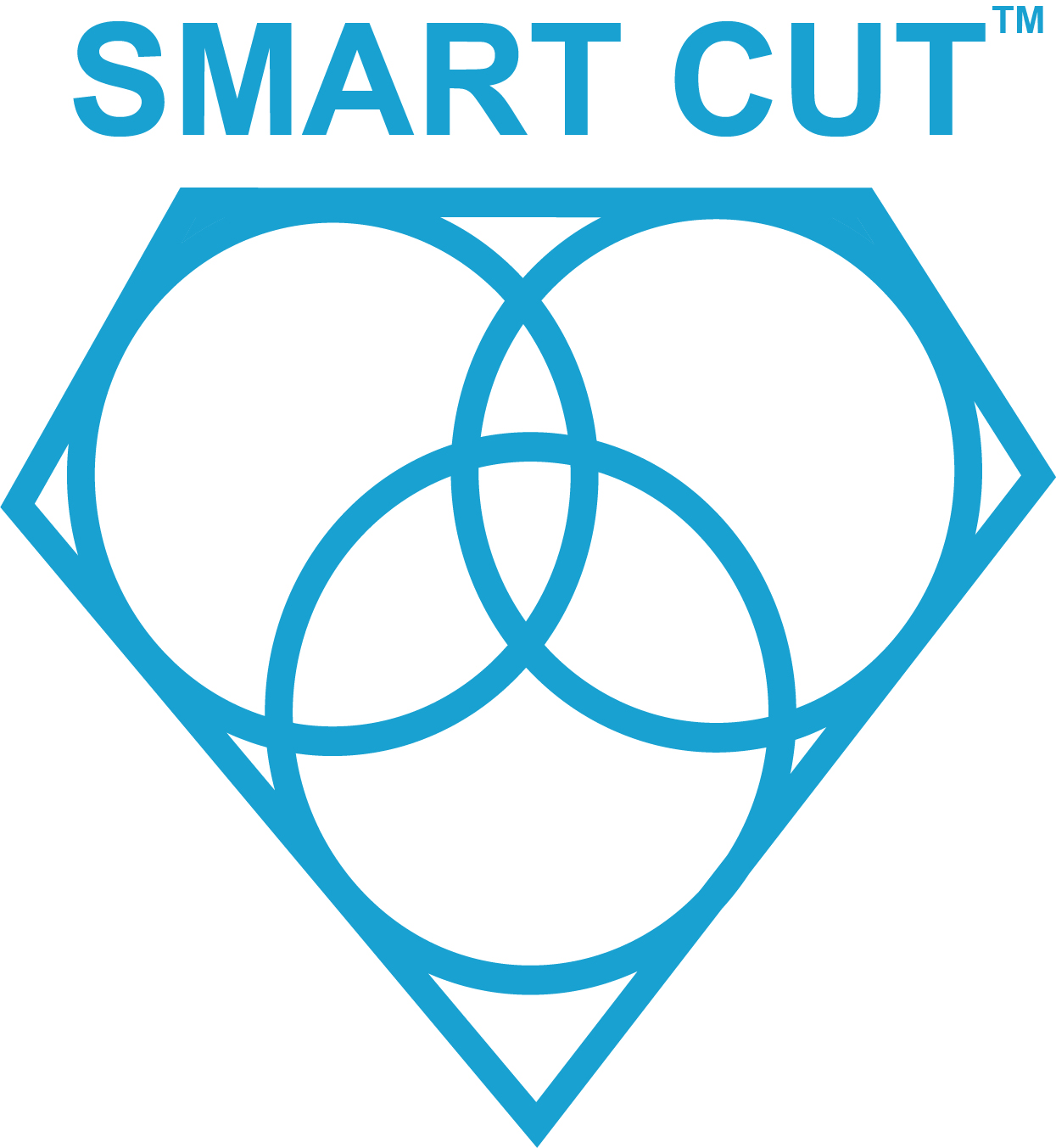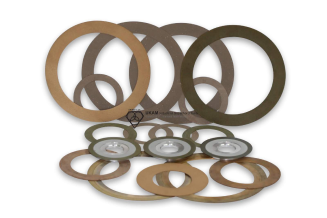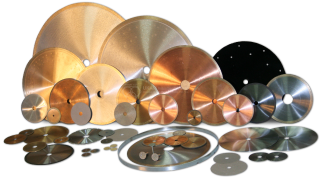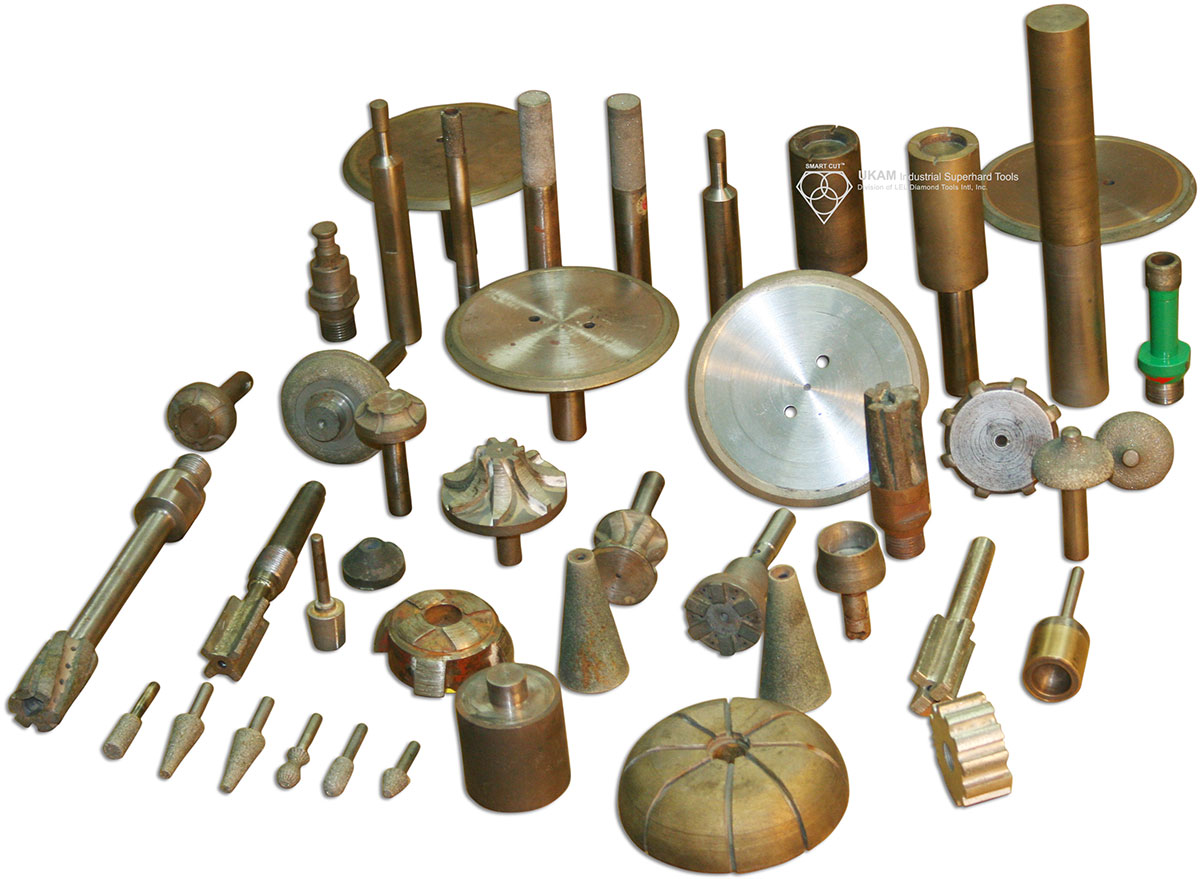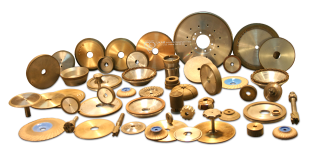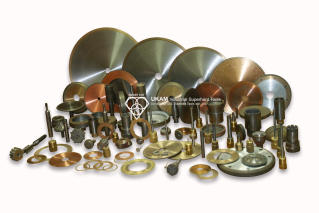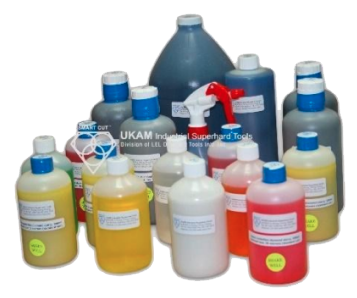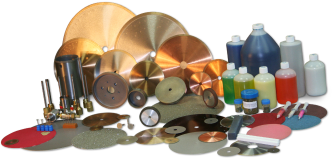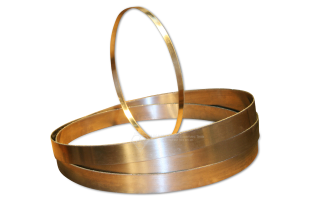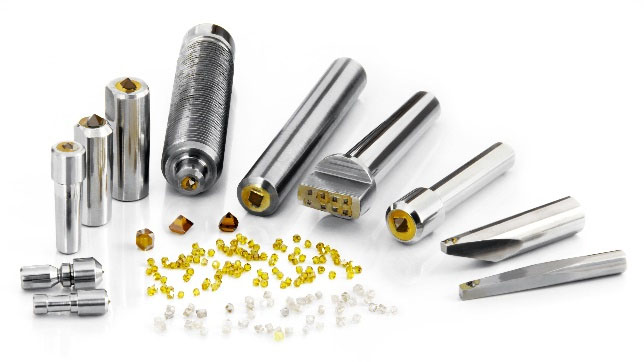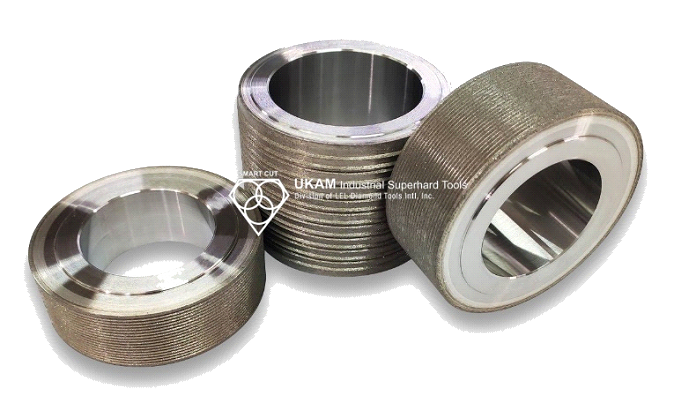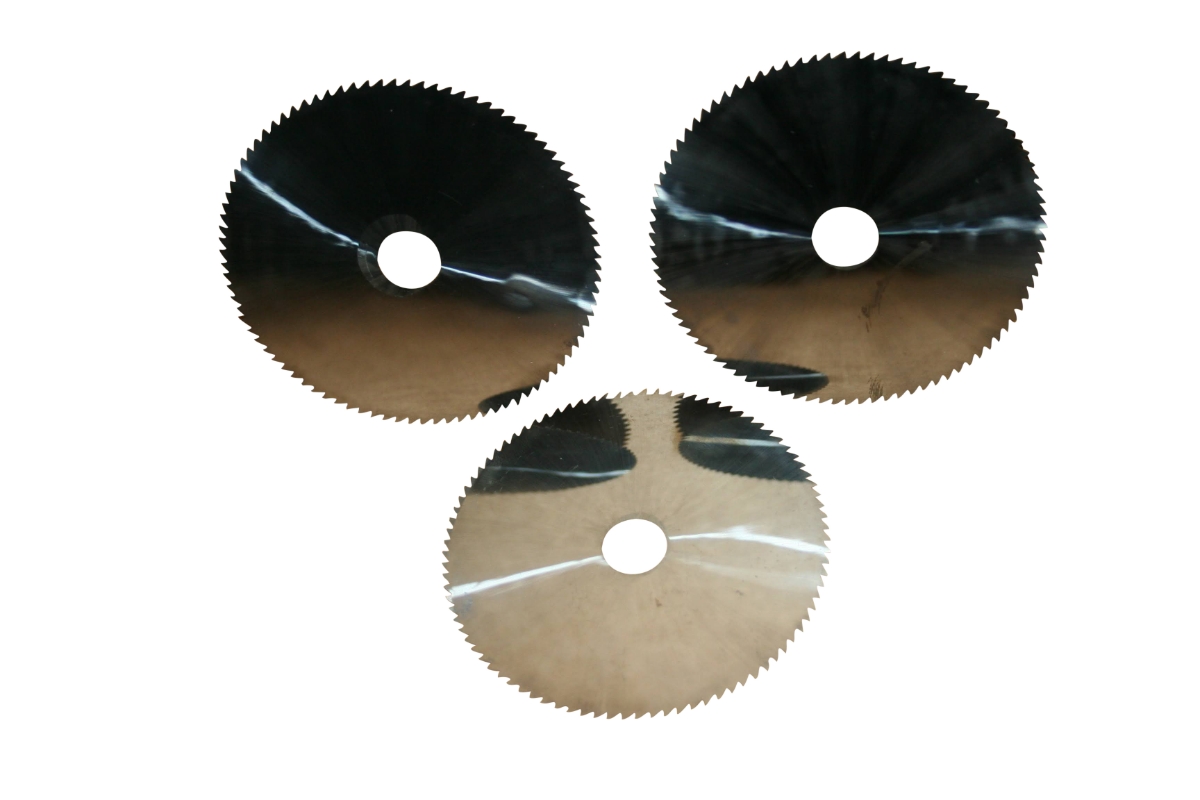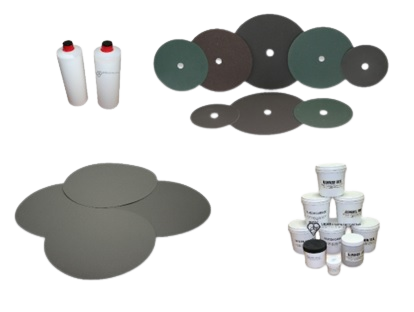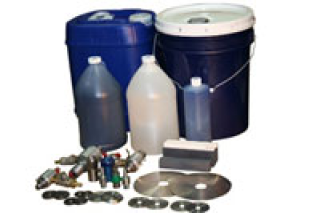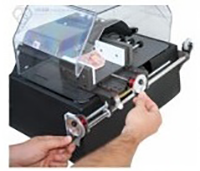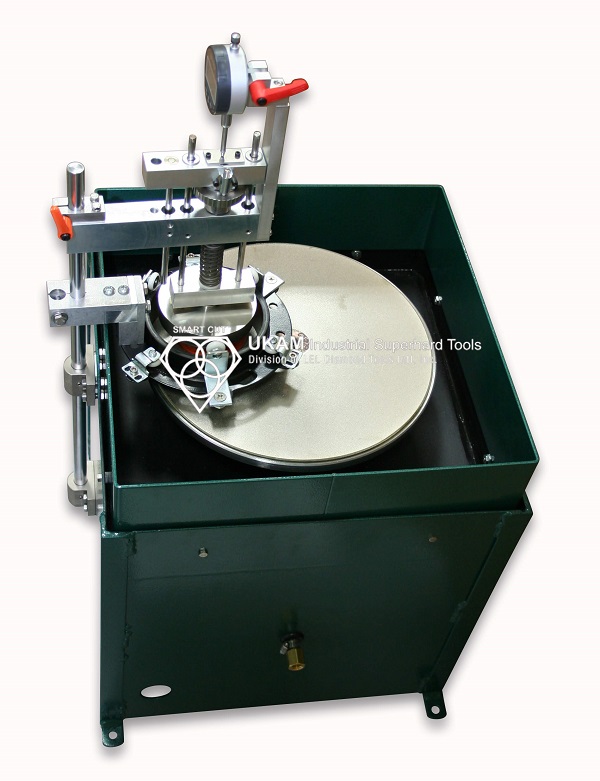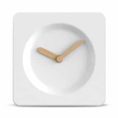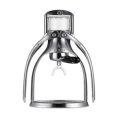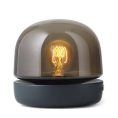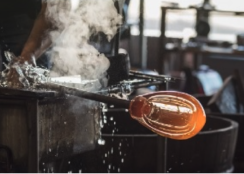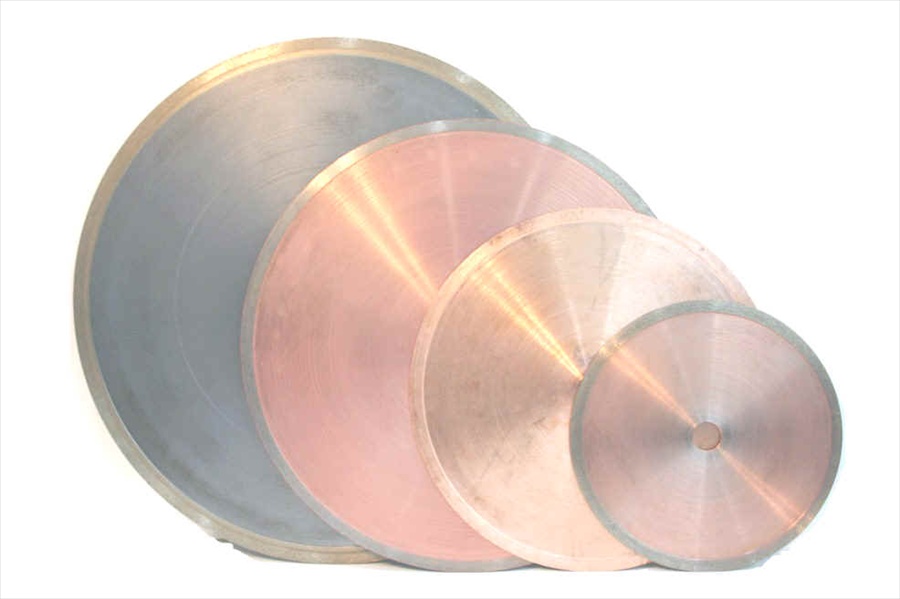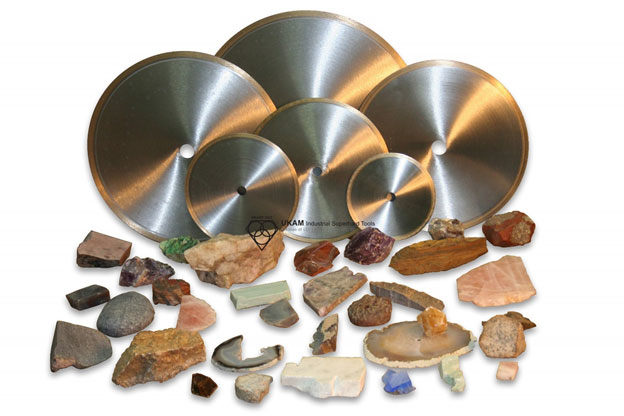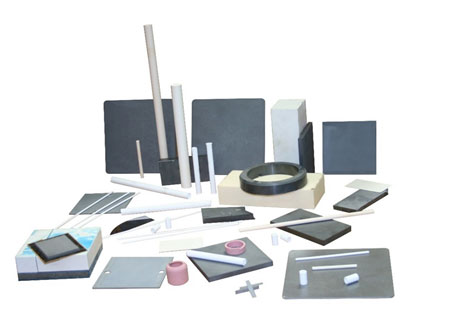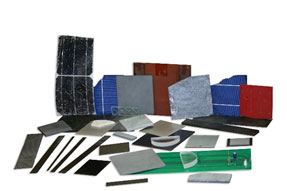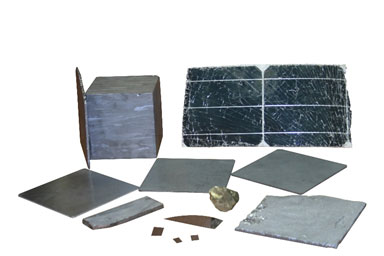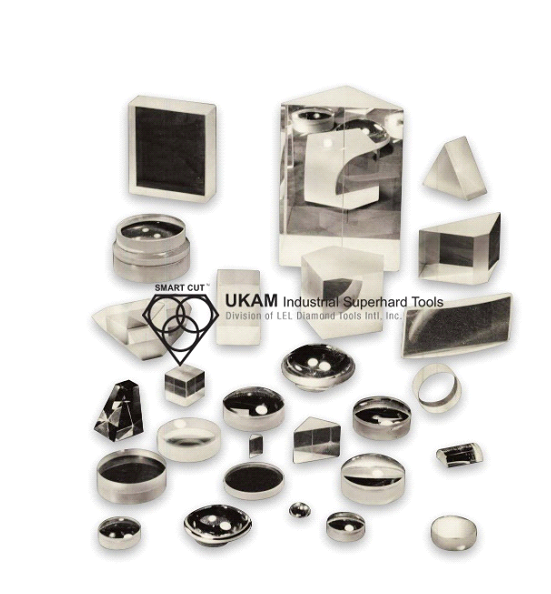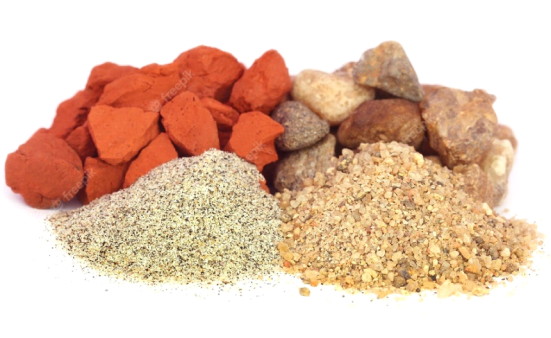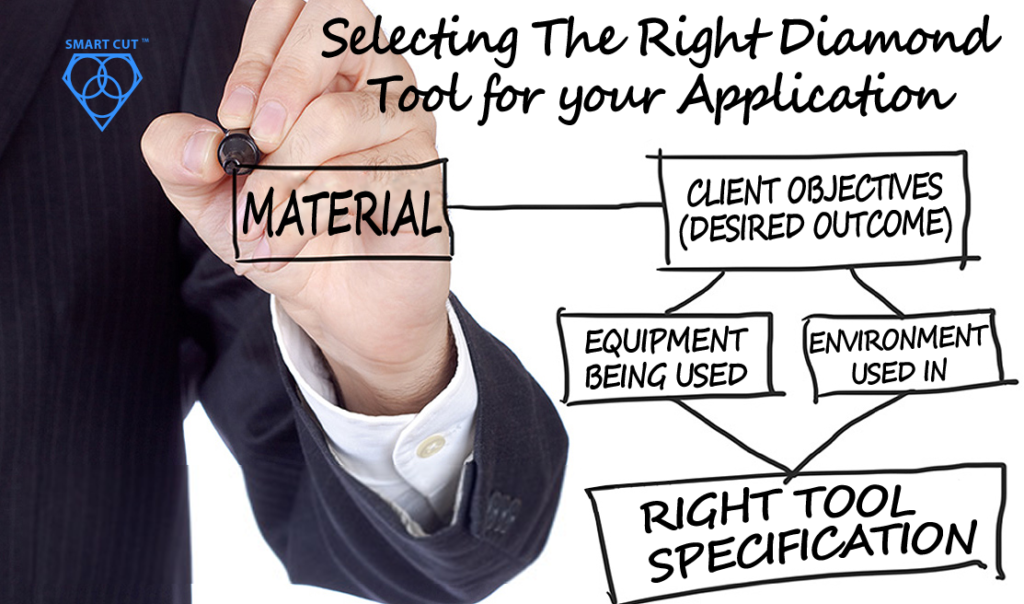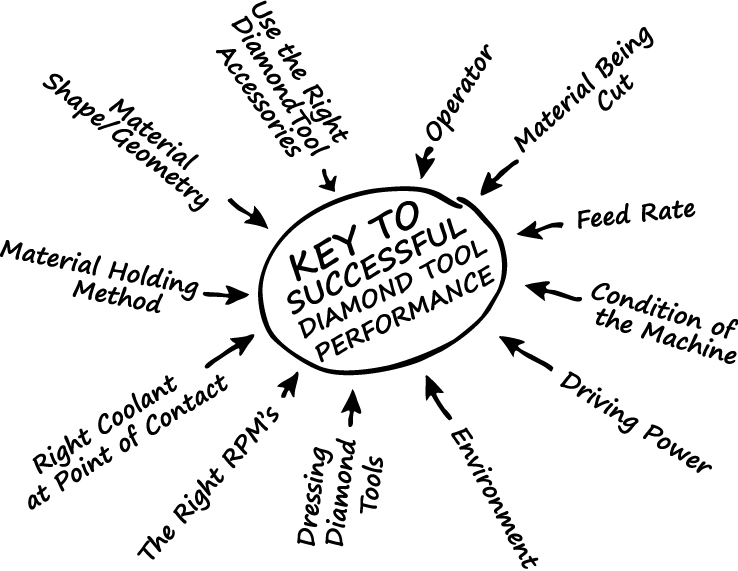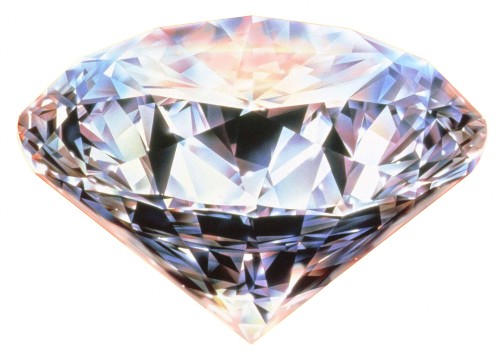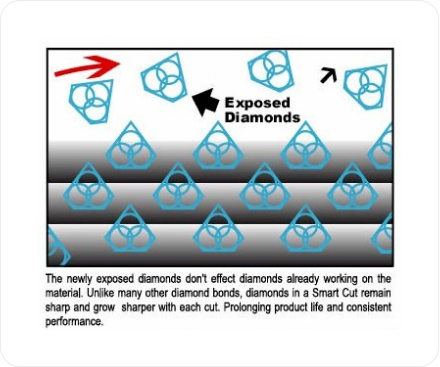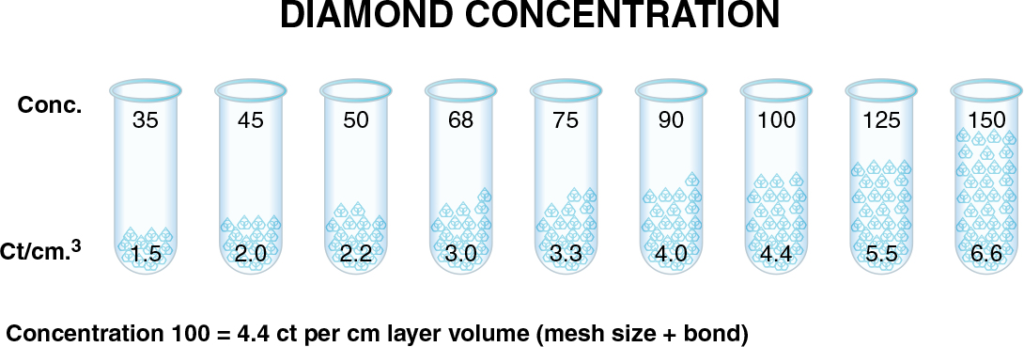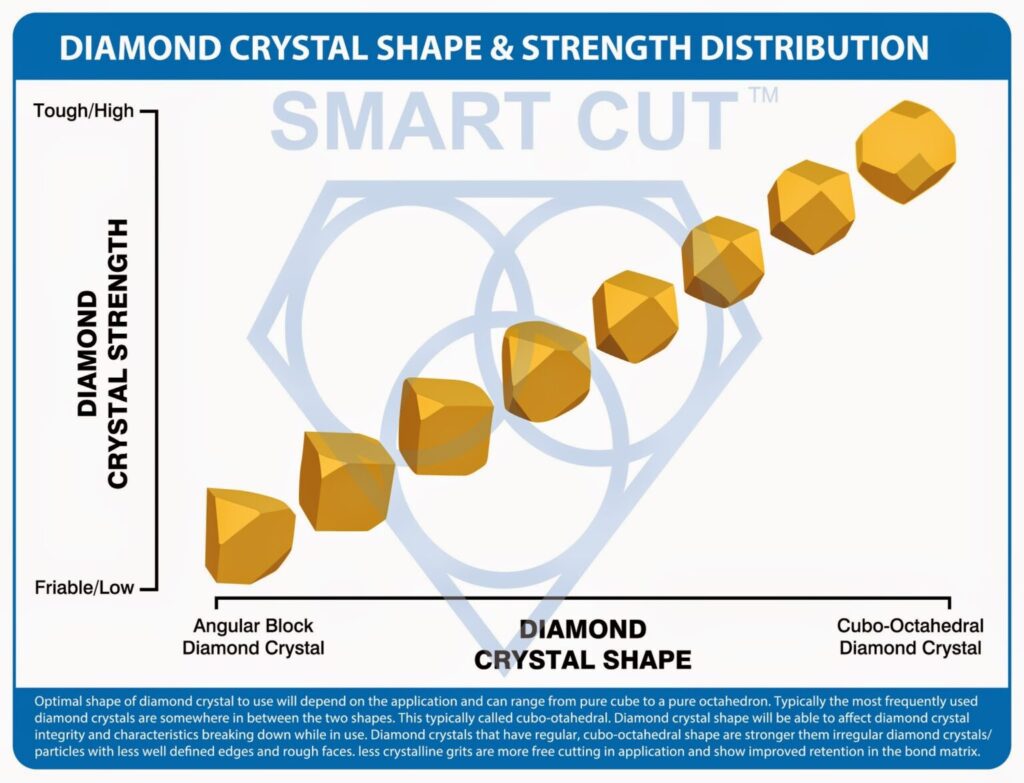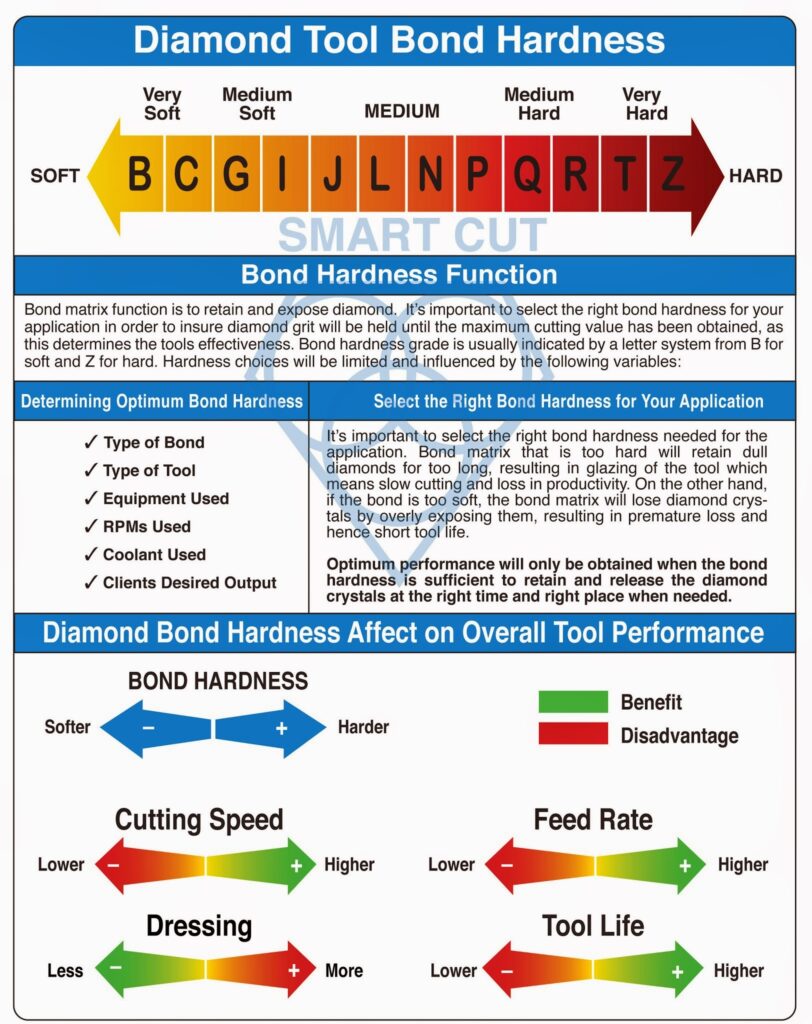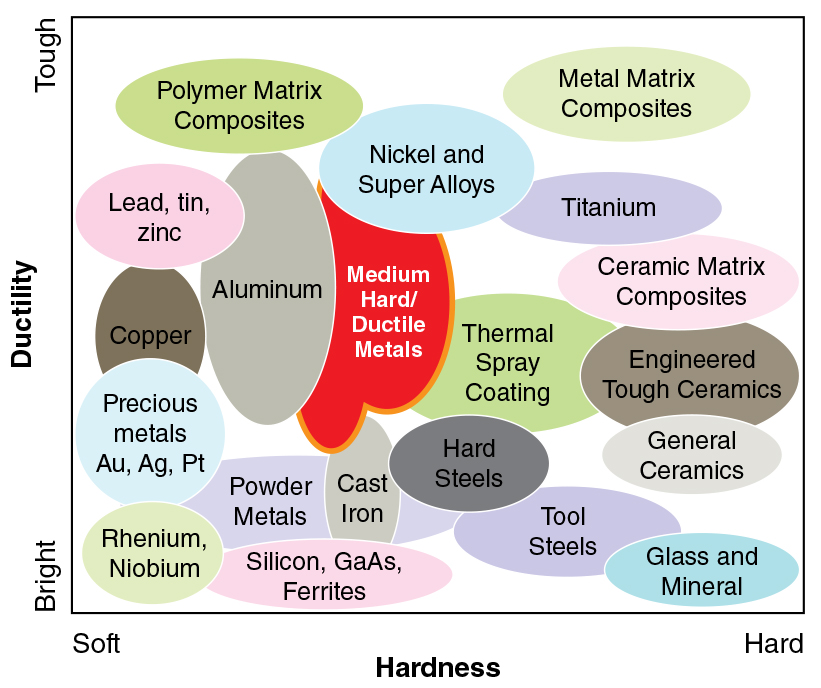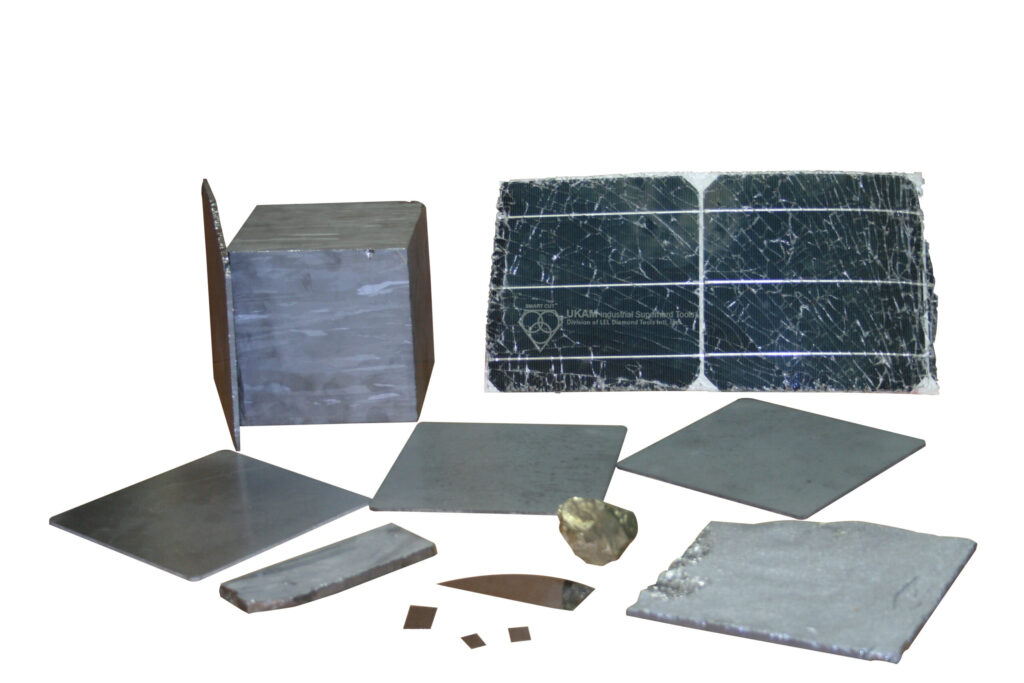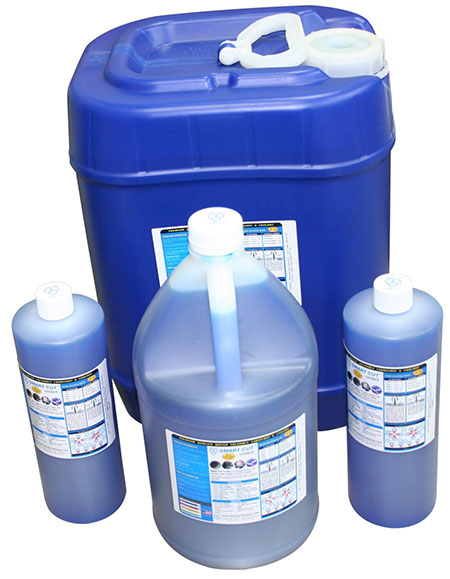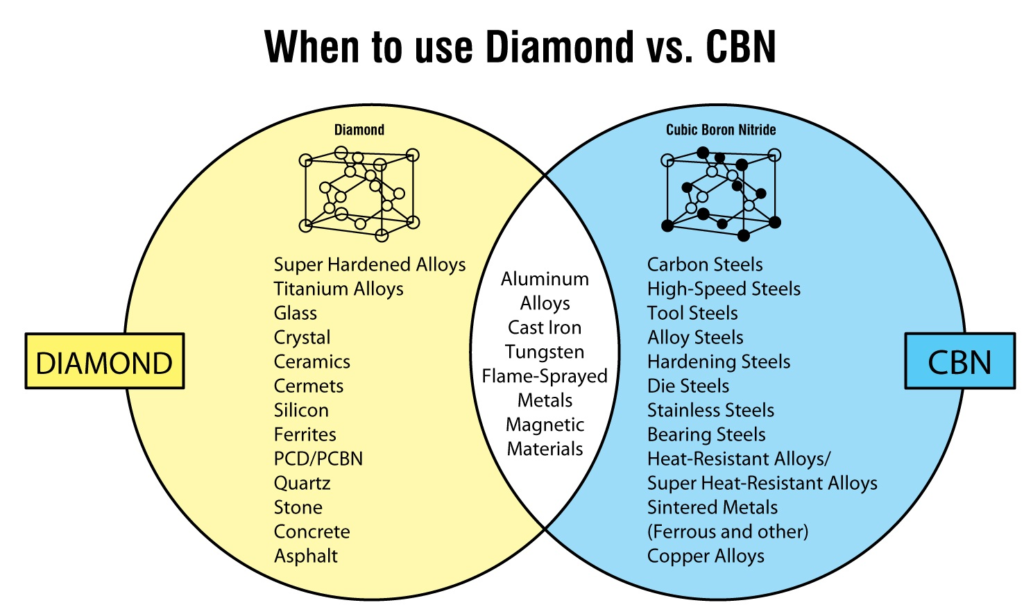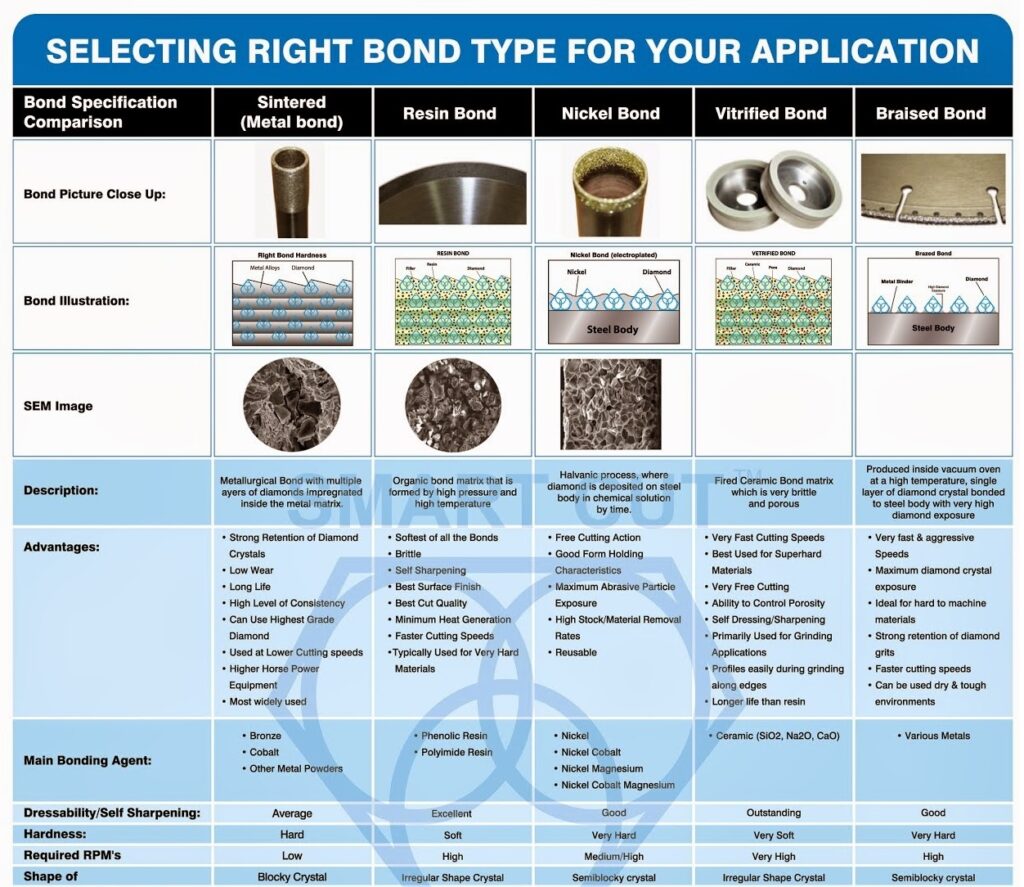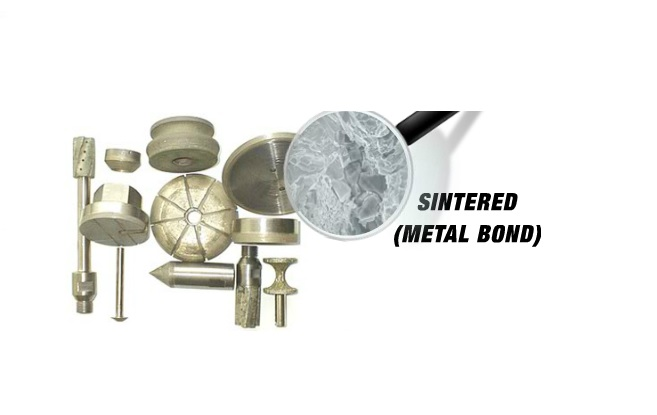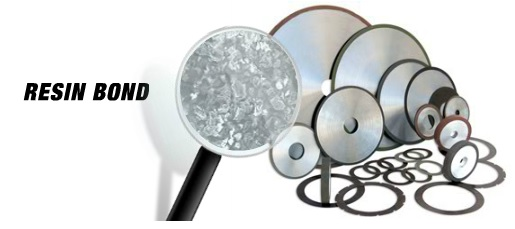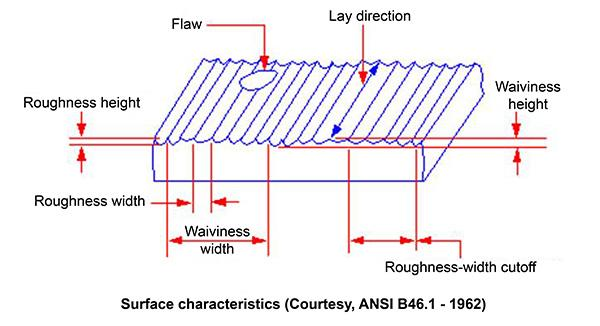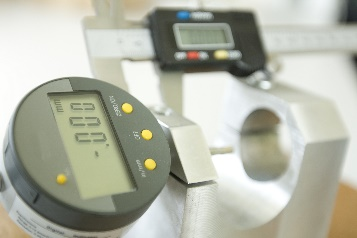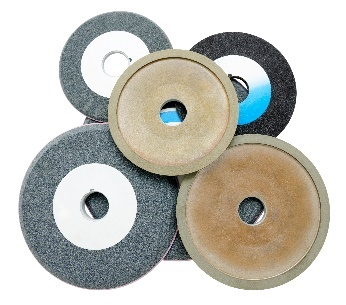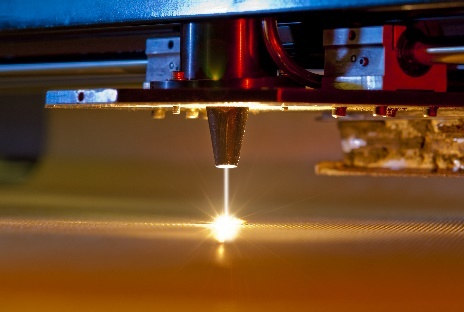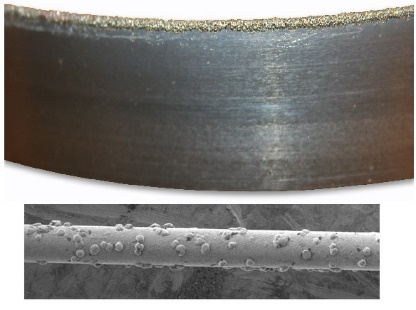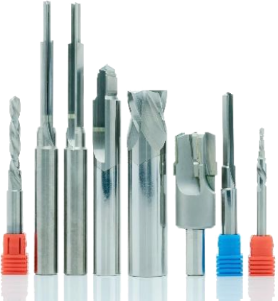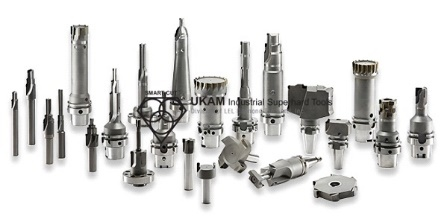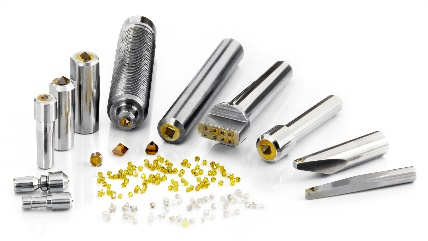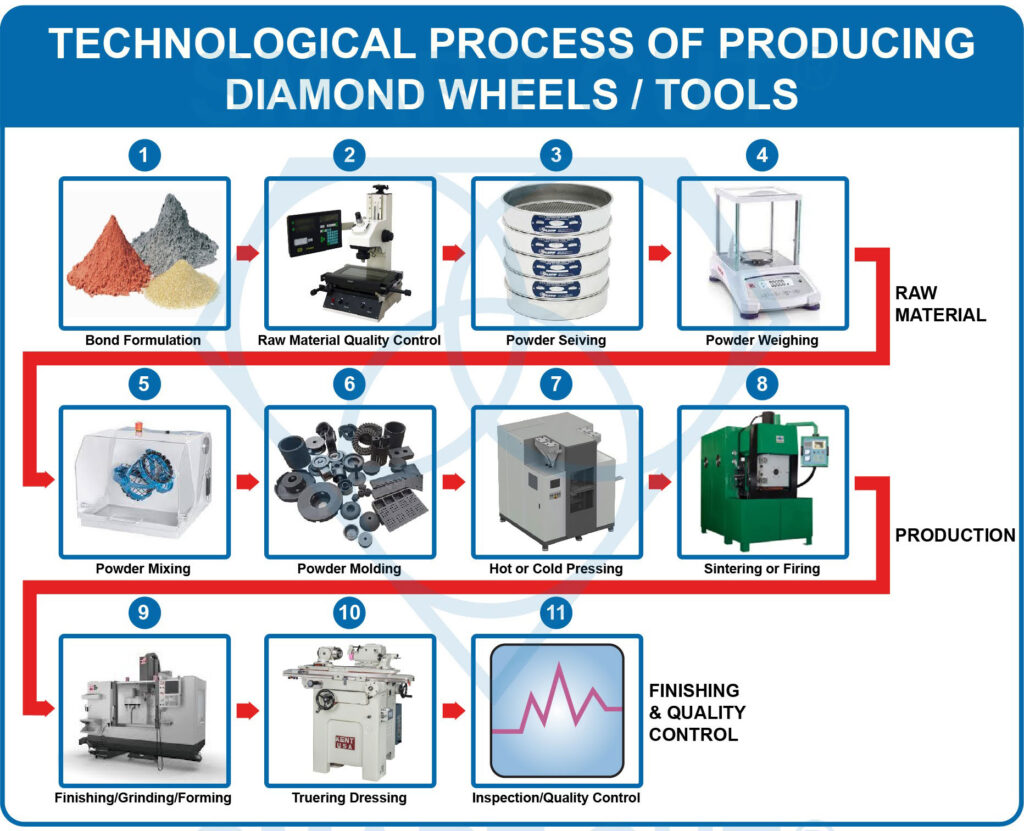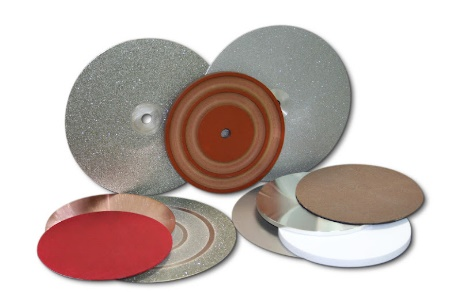Learn important diamond drill methodology. understand diamond drill specifications and their differences Selecting the right Diamond Drills/Bits for your application is key to obtaining desired diamond drilling results. Using the Right Diamond Drill will help you Save Time & Money. As well as avoid an unnecessary trial & error process.
Selecting the Right Diamond Drill / Bit for your application

Selecting the right Diamond Drills/Bits for your application is key to obtaining desired diamond drilling results. Using the Right Diamond Drill will help you Save Time & Money. As well as avoid an unnecessary trial & error process. The article below was designed for diamond drill/bit users of all skill and experience levels. Ranging from beginner (novice) to experienced manufacturing engineer, researcher, contractor or hobby enthusiast. The following are some factors to consider when selecting the right diamond drill for your application.
Today's growing variety and ever changing materials, Manufacturers, R & D facilities, hobbyists and everyone else involved in diamond drilling encounter wide variety of applications and challenges. The ever increasing variety of advanced, new generation, ultra hard, composite, micro, and exotic materials transform the way we look at diamond drilling. And set many age old diamond drills/bits and drilling methods obsolete. New materials require different technology and methods.
And although, today's market place offers the Manufacturing Engineer, R & D Scientist, Hobby Enthusiast, Contractor and Home Owner hundreds of choices of diamond drills/bits, accessories, and equipment. It offers little advice on how the user can implement these tools to accomplish their specific objectives. Many users still spend days and even weeks, trying different diamond drills/bits, and experimenting with different types of drilling equipment. An expensive and time consuming trial and error process, which can be avoided with proper understanding of your material and objectives you need to accomplish. Proper preparation, attention to detail, and following basic diamond drilling technique can make the difference in the success of your diamond drilling operation.
Material to Be Drilled
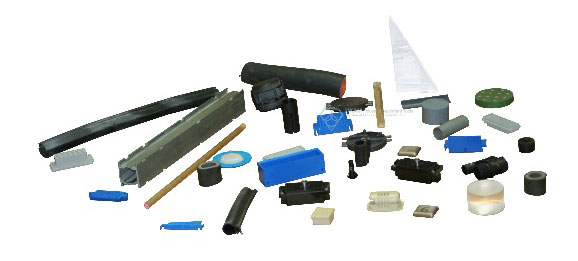

a.) Hardness of Material – Materials you are planning to drill will have a large impact in the types of diamond drills, equipment, and accessories you will be able to use. If you are drilling ultra hard materials such as sapphire, alumina, other types of advanced ceramics, high metallic content materials, precious and natural stone. It is generally recommended that you use a sintered (metal bonded) diamond drill. However, if you are drilling softer and less expensive materials such as glass, composites, soft stone and tile, an electroplated (nickel bonded) diamond drill may be a better and more cost effective solution. As a rule of thumb harder materials require softer bond, to drill faster and freer. While softer and abrasive materials require a harder bond, to last longer. Material Hardness is defined as the materials capability to resist deformation. All materials are classified by their scale of hardness. Material hardness is measured by many different hardness scales such as Mohs, Vickers, Knoop and other scales of hardness. Further information on determining and understanding hardness of your material is available in this article below.
b.) How expensive is your material - Material cost will play an important role in selection of the right diamond drill/bit for your application. if the material you are planning to drill is precious, valuable, or expensive. Diamond drill/bit cost will play a minor role in your drilling operation. It is suggested that you obtain a thin wall diamond core drill to minimize material loss and deformation. It’s always a good idea to have some type of an estimate of target cost and quality per hole.
c.) Material Thickness (maximum drilling depth) – The thicker the material you are planning to drill, the greater amount of coolant and pressure is required. Applications requiring you to drill over 1" (25.4mm) should be tread in a different way. We recommend running coolants from multiple directions. Through drill center, from side of drill, as well as drilling submerged in coolant. This will insure maximum amount of coolant and lubrication reaching your drilling zone. Running high pressure of coolant through center of your diamond drill/bit by using a water swivel adapter is highly recommended for drilling material over 1" (25.4mm) Thick. Longer Drilling depths may require drilling in several steps and using more than one diamond core drill / diamond drill bit.
d.) Material Geometry & Density - Each material has different density, hardness, composition. For this reason a diamond drills/bits and techniques that may work on one material, may not work on another material. To obtain optimum drilling results, each diamond drill should be ideally made to factor in the unique differences and properties of each material. Shape, Size, Diameter, Hardness, and Brittleness of your material will affect not only your diamond drill/bit selection, but your choice clamping methods (holding your material in place), drilling equipment, speeds & feeds you can use.
Equipment to be used
The equipment you will be using and its physical condition, will dictate the speeds (RPM’s), feeds, and coolants you can use along with your diamond drills/bits. Hence, somewhat limiting your diamond drill selection. No matter what diamond drill you use or how well its made, it will not provide the performance you are looking for, if you don’t use the right drilling equipment for your application. Diamond drills are usually used on the following equipment:
a.) Drill Press
b.) Angle Grinder/Hand Held Grinder
c.) Cordless Drill / Hand Held Drill
e.) High Speed Air Spindle
e.) Many Other Types of Equipment
Drill presses, milling machines, or CNC machines are used in most industrial manufacturing applications. R & D facilities also tend to utilize the same equipment. Hobby Enthusiasts, Contractors, and Home Owners most often use hand held Drills, followed by drill presses, drilling rigs, and angle grinders. Proper drilling equipment for your diamond drilling application is discussed in further detail in this article below.
Application / Number of Holes to be Drilled
Your diamond drill requirements will greatly vary with your application & frequency of use and diamond drill/bit intended application. Diamond Drills, Diamond Core Drills, Diamond Drill Bits, Diamond Bits (usually mean same thing) are generally used for:

a.) Industry / Production - Diamond Drills/Bits are used everyday in thousands industries & operations to manufacture products yield (output per cost) from their diamond drills/bits. What is common about these applications is the Diamond Drill/Bit will be used every day or several times a day, drilling several thousand holes/cores or until the drill is warn out and replaced. Metal Bond (Sintered) diamond drills are usually recommended for this type of heavy duty use. However, if you have a very fine or specific finish requirement and do not polish material after drilling. HYBRID Bond diamond drill or even Multi-Layered Electroplated Diamond Core Drills used with water swivel adapter to run high pressure of coolant through center of your diamond drill/bit may be the best solution for your application. No matter what stage your manufacturing operation, UKAM Industrial Superhard Tools has the Experience & Solutions to help you resolve even the most complex manufacturing challenges. Discover why thousands of manufacturing around the world turn to UKAM Industrial Superhard Tools to optimize their diamond drilling & machining operation to ultimate level of efficiency. that play an important role in our everyday lives. Ranging from advanced/technical ceramic parts machining, composite aerospace applications, optical lenses machining, stone countertop fabrication and much more. Diamond Drill & technical requirements are diverse as the manufacturing operations that use them. Typically manufacturing engineers & machinists demand a high level of consistency, accuracy,
b.) Research & Development - Diamond Drill requirements in Research are diverse as fields and researchers that used them. Whether is drilling a hole or obtaining core sample. Most researchers & application engineers are primarily concerned about preserving material true micro structure and introducing least amount of damage & deformation possible to material being worked on. Research Applications range from materials sciences, advanced materials, advanced/technical ceramics, optics, metallography, geology, composites to new and breakthrough fields such as MEMS, Biotechnology and Nano Technology. Typical Research diamond drill/bit users include Universities, Government or Commercial Laboratories, Military Research Facilities, Space & Science Organizations, as well as R & D departments of large organizations. UKAM Industrial Superhard Tools understands the challenges faced by faced by R & D Organizations and has developed diamond drills/bits, accessories, and TOTAL SOLUTIONS to address most common R & D applications. We are constantly engaged in R & D and process development ourselves to keep up with increasing demands of the complex / advanced material world / community.
c.) Hobby / Craft – Diamond Drills/Diamond Drill Bits are used for thousands of diverse type of art & craft applications. Materials frequently range from river rocks, all types of glass, jewelry, beads, lapidary (semi precious & precious stones). What is common about many of these applications is that the diamond drill will be used occasionally for a specific job and than stored for later use. If you are planning to make less than a 100 holes, we recommend you use an electroplated (nickel bonded) diamond drill. Electroplated diamond drills are recommended for beginning (novice) users, because they are usually more forgiving to operator error & mistakes. However, if you are planning to use the drill a number of times through the year. Sintered (metal bonded) diamond drill is a better overall solution and investment. Whether you are just starting out or are an experienced/accomplished crafts person, UKAM Industrial Superhard Tools has the solution to optimize your diamond drilling operation and help you reach the next level. Save money, time, and frustration. By using the right diamond drill/bit for your application the first time. Discover why the leading artisans commissioned by well known organizations such as Faberge, Courtie, Antique Restoration Houses, well known glass & stained glass artists, and jewelry manufacturers use & prefer diamond drills/bits manufactured by UKAM Industrial Superhard Tools.
Diamond drills for contractor applications
User Goals / Objectives
a.) Drill Hole in Material

most drilling application involve drilling holes in variety of materials. In this case a hole is the end product. And obtaining an even, round hole is the desired result. The users focus should be on (OD) Outside Diameter of the drill. Either a hallow Diamond Core Drill or Diamond Solid Drill (without hole) can be used for this application. Faster drilling speeds and more efficient drilling results will be obtained with a so called Hallow Diamond Core Drill. Diamond Sold Drills are primarily used for drilling smaller size holes from .001" to 3/8". Hollow Diamond Core Drills are used for drilling larger size holes.
b.) Obtain Core (material plug)
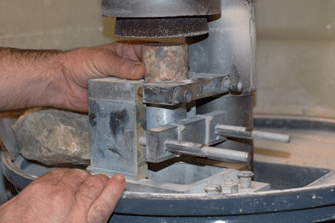
for some diamond drill users, obtaining the material core (center plug) that becomes stuck inside the core drill is the desired result. In this case the material core (plug) is the end product, not the hole itself. A core can only be obtained using so call "hallow diamond core drill". The diamond drills (ID) Inside Diameter becomes a critical dimension (parameter). We often manufacture diamond core drills, specifically to fit each individual customers requirements and tolerances. Please, specify that you need to obtain the Core when ordering diamond drills. Inside Diameters (ID) for most of our standard stock drills are listed in our web site.
Ejecting the center core from center of diamond core drill becomes an important factor. Core can be manually removed from core drill through center of drill or slots provided on body of diamond drill. The most efficient way of removing core from center of drill, is using high pressure of coolant from water swivel adapter. Just increase pressure of coolant, every time core becomes stuck inside your drill. This is the fastest, easiest, and most efficient method for removing material center core.
Technical Requirements/Specifications
d.) Chipping/Finish Requirements – Diamond Mesh Size (grit size) of your diamond core drill/drill bit will play a major role in determining the surface finish quality, smoothness, level of chipping, and material microstructure damage/deformation you will obtain. if you have an application where surface finish and chipping is a critical factor, a sintered (metal bond) diamond drill with a very fine diamond grit may be the best solution. Using Multi-Layered Electroplated Diamond Core Drills in combination with water swivel adapter to run high pressure of coolant through center of your diamond drill/bit. And synthetic water soluble coolant will help you obtain the best surface finish quality possible. More detailed explanation of diamond mesh size in correlation to surface finish quality is presented in this article below.
e.) Tolerances – if you are using diamond drills to drill holes in a product that requires on specific tolerances, you will need a custom diamond drill specifically designed for your application. Tolerance may be specified on OD, ID, run out and concentricity of the diamond drill.
f.) Material Cost – if the material you are drilling drill precious, valuable, or expensive. The diamond drill cost will play a minor role in your drilling operation. It is suggested that you obtain a thin wall diamond core drill to minimize material loss and deformation. It’s always a good idea to have some type of an estimate of target cost and quality per hole.
Coolant to be used
Your capability to use coolant while drill, will seriously effect your diamond drill selection. Most diamond core drills must be used with coolant. Typical coolants used with diamond drills/bits include regular city water, synthetic water soluble coolant, & mineral oil. Shorter drill life, material and drill deformation will result when using drills dry. Electroplated (nickel bonded) diamond core drills may be used dry (without water) depending on the application (material being drilled). UKAM Industrial Superhard Tools does have the capability to manufactured diamond drills to be used without coolant. However, using diamond drills dry is not recommended on most applications. When chance prevails, use all diamond drills with coolant. If use of coolant with your diamond drill/bit is not possible for fear of contamination or any other reasons, consider using compressed air as form of coolant. Although it will not substitute coolants described above, it will be better than drilling dry.
Diamond Drill Variables
Bond Hardness – Ability of the bond matrix to hold diamonds. As the hardness of the bond is increased, its diamond retention capabilities increase as well. However the trade off is slower drilling speed. Life of the diamond drill is usually increased with hardness of its bond matrix. Bonds are designated on their scale of hardness from Soft, Medium, and Hard. There are dozens of variations and classification schemes based on bond degree of hardness or softness. Using diamond drills with optimum bond hardness for your application is important to successful drilling operation. Bond matrix that is too soft for the material being drilled will release diamond particles faster than needed, resulting in faster wear and shorter diamond drill life. On other hand bond matrix that is too hard will result in much slower drilling speeds and require constant dressing to expose the next diamond layer. As rule of thumb, harder materials such as sapphire and alumina (Al203) generally require a softer bond. Whereas softer and more brittle materials require a harder bond.
EXAMPLE OF DIAMOND CORE DRILL BONDS & THEIR APPLICATIONS FOR SINTERED (METAL BOND) DRILLS


Diamond Grit Size (Mesh Size) – grit size (mesh size) is generally selected depending on the speed you wish to operate the drill and surface finish of your material. The size of the diamond crystals, commonly referred to as mesh size, determines the number of diamond cutting points exposed on the surface of a diamond drill. Diamond Mesh/Grit Size is similar to various grit sizes found on sand paper, which usually comes in coarse, medium, find, & super fine grits. According to U.S. Standards, mesh designates the approximate number of sieve meshes per inch. High Mesh Sizes mean fine grits, and low numbers indicate coarse grits. Diamond Mesh Size plays a major role in determining the surface finish quality, smoothness, level of chipping, and material microstructure damage/deformation you will obtain.
Finer mesh size diamonds such as 220 and 320 grit are much smaller in size than coarser diamond particles. And will give you a very smooth surface finish, with minimal amount of chipping on edges. These mesh sizes are usually used for drilling advanced and optical materials such as: LiNbO3, YVO4, GaAs, and optical materials.
Courser diamond particles such as 80 and 100 grit are much larger in diameter and are frequently used fast drilling / material removal on more harder materials such as granite, sapphire, stone, silicon carbide, zirconia, Al2O3, stainless steels, and other advanced ceramics and materials with high metallic content. Which usually do not require a very fine surface finish.
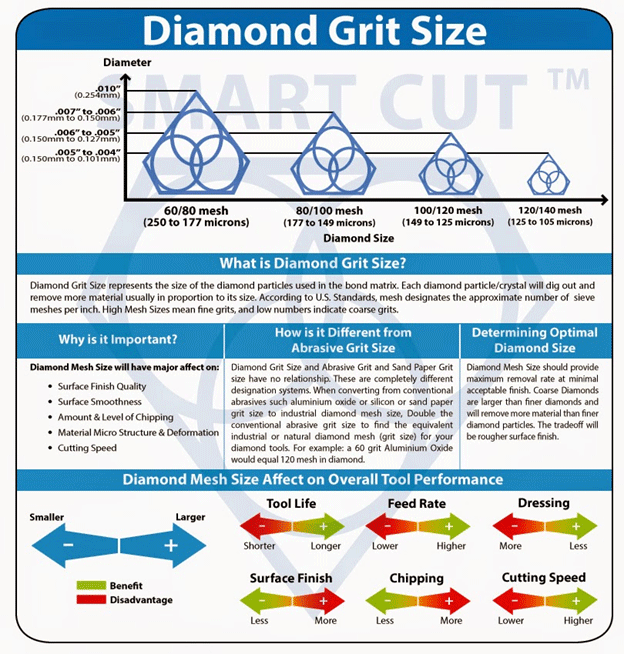
The diamond mesh size in a cutting tool also directly relates to the number of crystals per carat and the free cutting capability of the diamond tool. The smaller the mesh size, the larger the diamond crystals, while larger mesh size means smaller diamond. A 30/40 Mesh blocky diamond has about 660 crystals per carat, while a 40/50 Mesh diamond will have 1,700 crystals per carat. Specifying the proper mesh size is the job of the diamond drill manufacturer. Producing the right number of cutting points can maximize the life of the tool and minimize the machine power requirements. As an example, a diamond tool manufacturer may choose to use a finer mesh size to increase the number of cutting crystals on a low concentration tool, which improves tool life and power requirements.
Diamond Mesh size does have considerable effect on drilling speed. Coarse Diamonds are larger than finer diamonds and will remove more material than finer diamond particles. This means that coarse diamond drills are more aggressive for material removal than the finer diamond drills and will drill faster. However, the tradeoff is increase in material micro structure damage. If you are drilling fragile, more delicate materials then finer mesh size diamond drills are recommended. Diamond mesh size (grit size) should provide maximum removal rate at minimal acceptable finish. Often the desired finish (hole/core quality) cannot be achieved in a single step/operation. Lapping or polishing may be necessary to produce desired surface finish, as a secondary step in your diamond drilling operation / process.
Understanding Diamond Drill/Bit Mesh/Grit Size & Surface Finish Quality
When converting from conventional abrasives such aluminum oxide or silicon or sand paper grit size to industrial diamond mesh size, double the conventional abrasive grit size to find the equivalent industrial or natural diamond mesh (grit size) for your diamond drills/bits. For example: a 60 grit Aluminum Oxide would equal 120 grit in diamond.
Diamond Definition
Diamond Mesh/Grit Size
Diamond Micron Size
Recommended Application
Approximate RMS
Saw Grit
40/60
297
Sawing
125-200
Super Course
60/80
213
Roughing (Heavy Stock Removal)
125-150
Large Course
80/100
163
Medium Roughing (General Drilling)
90-125
Course
100/120
137
Semi Roughing (Semifinish Drilling)
64-90
Medium
140/170
97
Rough Finishing (Finish Drilling)
32-48
Fine
200/230
68
Finishing
20-24
Extra Fine
270/325
49
Fine finishing
14-16
Super Fine
325/400
47
Extra finishing
14-15
45 Microns*
400/500
45
Super finishing
13-14
30 Microns*
500/600
30
Polishing
12
15 Microns*
800/1200
15
Polishing
12
9 Microns* 8/10 6/12
1,800
9
Polishing
6 Microns* 4/8
3,000
6
Fine polishing
3 Microns*
8,000
3
Extra polishing
Diamond Concentration - The proportion, and distribution of diamond abrasive particles, also known as concentration. Has an effect on overall drilling performance and price of your diamond drill. Diamond concentration, commonly referred to as CON, is a measure of the amount of diamond contained in a

The bond, defined as: Concentration 100 = 4.4 ct per cm layer volume (mesh size + bond). Based on this definition a concentration of 100 means that the diamond proportion is 25% by volume of diamond layer, assuming at diamond density is 3.52 g/cm3 and 1 ct = 0.2g.


Nominal diamond concentration in precision diamond drills range from 0.5 ct/cm3 to 6 ct/cm3. This means diamond concentrations are available from 8 to 135). Selecting the Right Diamond Concentration can be critical in optimizing your Diamond Drilling Operation. Selecting Optimum Diamond Concentration for your application will depend on a large number of factors, such as:
-
 Material Being Drilled
Material Being Drilled
-
 Diamond Drill Bond Type and Hardness
Diamond Drill Bond Type and Hardness
-
 Diamond Mesh Size
Diamond Mesh Size
-
 Drilling Speeds
Drilling Speeds
-
 Coolants being used
Coolants being used
Diamond Concentration will play a major role in determining the life and drilling speed of your Diamond Drill. Higher diamond concentration is recommended and usually used for cutting softer and more abrasive types of materials. However, the trade off is significantly slower drilling speed. Low diamond concentration is recommended and widely used for drilling ultra hard and brittle materials. Optimum performance can be achieved when the diamond tool manufacturer utilizes their experience and analytical capabilities to balance diamond concentration and other factors to achieve optimum performance for the diamond drill/bit user. UKAM Industrial Superhard Tools has the experience & applications laboratory to help you select all the right variables for your unique application.
Wall Thickness – the thinner the wall thickness of your diamond drill/bit, faster the speed (RPM) your drill may run, less chipping and heat your drill generates, and smoother and higher quality of the finish. Thin wall diamond core drills provide the following advantages:
-
 less loss of material
less loss of material
-
 minimum material deformation
minimum material deformation
-
 less heat generation
less heat generation
-
 faster drilling speed
faster drilling speed
-
 less chipping
less chipping
-
 better finish quality
better finish quality
The trade off is shorter diamond drill life. Thin wall diamond core drills will wear much faster thicker wall diamond drills. UKAM Industrial Superhard Tools has the capability to manufacture diamond core drills with wall thickness as ULTRA THIN as .003" (76 microns) to as thick as .236" (6mm) & as thick as you want
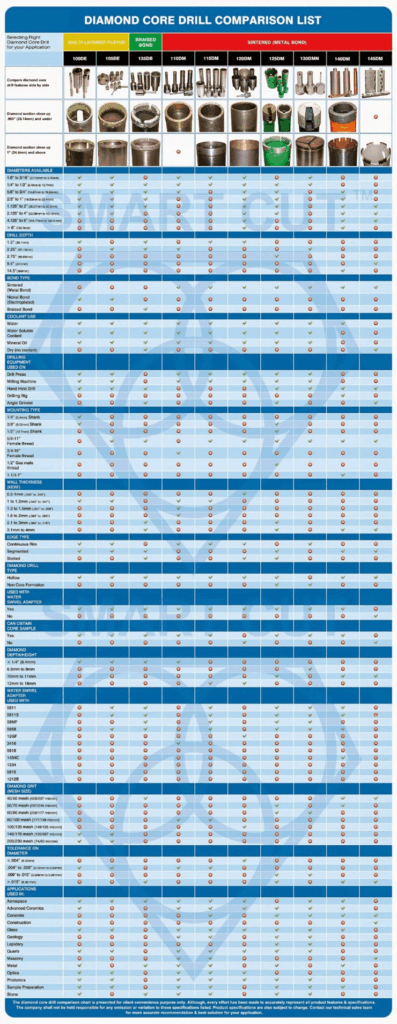
DIAMOND DRILL SELECTION PARAMETERS
Wall thickness
Lorem ipsum dolor sit amet, consectetur
Ultra thin wall (.010” to .020”)
Very Thin Wall .021” to .040”
Thin Wall (.041” to .060”)
Standard Wall (.061” to .100”)
Heavy Wall (.100”+)
Diameter
.001” to .005”
.006” to .030”
.031” to .124”
.125” to .500”
.501” to 3.99”
4.0” to 11.99”
12.00” +
Bond Type
Nickel bond (electroplated)
Sintered (metal bond)
Braised bond
Chemical Vapor Deposition
Polycrystalline
Mounting Type
2.35mm straight shank
3mm straight shank
6mm straight shank
¼” shank
3/8” straight shank
½” straight shank
5/8-11”
5/8-18”
¾-16”
½” gass
1-14”
1-1/4-7”
unmounted
other
Coolant Used
yes
no
Tolerances on diameter or ID


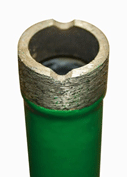
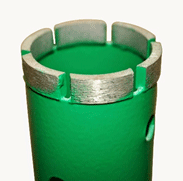


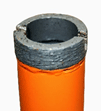
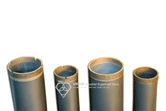
DIAMOND CORE DRILL / BIT DESIGN

Most often used collets are 5/8-11", 5/8-18, 1-14, 3/4-16, 7/8-14, 1-1/4-7", BRANSON (Ultrasonic) and Others. Standard shank sizes are usually 1/4", 3/8", and 1/2" diameter.
UKAM Industrial Superhard Tools manufactures & stocks Diamond Drills/Bits to customer desired specifications, outside & inside diameters, drilling depths, bond types, diamond grit sizes, mountings, & tolerances. Below is a diagram (technical drawing) that will help you better understand different diamond drill/bit specifications that can be altered based on your requirements.
Diamond Core Drill/Bit Mounting Methods: Diamond Drills/Bits must be either mounted on a collet or made with straight shank. Diamond Drills mounted on a collet can be used with water swivel adapter to run high pressure of coolant through center of drill. Diamond drills with straight shank are meant to be placed in drilling machine chuck and cannot be used with water swivel adapter. We recommend using diamond drills/bits that are mounted on a collet. You can always purchase a shank adapter that will thread into the collet, that will convert your diamond drill into a straight shank mounting. Various industries used different collets (mounting methods).
DIAMETERS:
D = Outside Diameter D1 = Inside Diameter D3 = Shank Diameter
D4 = Shank Inside Diameter
HEIGHTS:
H = Total Drill Length H1 = Diamond Depth (diamond height) H2 = Drilling Depth (how deep you can drill) H3 = Shank Length
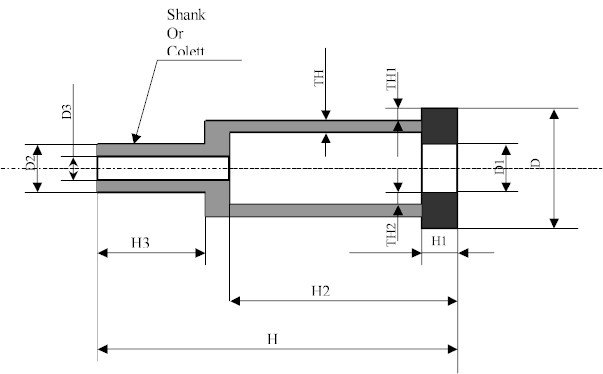
THICKNESS:
TH = Drill Tube Wall Thickness TH1 = Outside Diameter Diamond Section Relief TH2 = Inside Diameter Diamond Section Relief

Diamond Core Drill Types:
Diamond Solid Drill/Tool Types:
-
 diamond hollow core drills unmounted (tube only)
diamond hollow core drills unmounted (tube only)
-
 diamond hollow core drills mounted (with female or male thread or straight shank per client spec)
diamond hollow core drills mounted (with female or male thread or straight shank per client spec)
-
 ID Core drills
ID Core drills
-
 non core formation
non core formation
-
 bottoming drills
bottoming drills
-
 diamond dual core drills.
diamond dual core drills.
-
 disintegrating drills
disintegrating drills
-
 diamond chamfering tools
diamond chamfering tools
-
 diamond seamers
diamond seamers
-
 diamond hole saws
diamond hole saws
-
 ultra thin wall diamond core drills
ultra thin wall diamond core drills
-
 thin wall diamond core drills
thin wall diamond core drills
-
 standard wall diamond core drills
standard wall diamond core drills
-
 heavy wall diamond core drills
heavy wall diamond core drills
-
 Continuous Rim (Crown) Diamond Core drills
Continuous Rim (Crown) Diamond Core drills
-
 Slotted diamond core drills
Slotted diamond core drills
-
 segmented diamond core drills
segmented diamond core drills
-
 diamond core drills for ultra sonic drilling machines
diamond core drills for ultra sonic drilling machines
-
 concrete & construction diamond core bits
concrete & construction diamond core bits
-
 diamond carving points
diamond carving points
-
 diamond mounted points
diamond mounted points
-
 diamond counter tools
diamond counter tools
-
 diamond grinding pins
diamond grinding pins
-
 diamond routers
diamond routers
-
 diamond ID grinding points
diamond ID grinding points
-
 diamond jig grinding mandrels/pins
diamond jig grinding mandrels/pins
-
 diamond countersinks
diamond countersinks
-
 diamond counter bores etc
diamond counter bores etc
-
 Diamond Milling Tools
Diamond Milling Tools
-
 Diamond Generating Tools
Diamond Generating Tools
-
 diamond face grinding tools
diamond face grinding tools
-
 Diamond Chamfer Tools
Diamond Chamfer Tools
-
 Diamond Radius Tools
Diamond Radius Tools
-
 Diamond Profiling Tools
Diamond Profiling Tools
-
 Diamond Ball Nose Tools
Diamond Ball Nose Tools
-
 Diamond Round End Tools
Diamond Round End Tools
-
 Diamond Full Ball Tools
Diamond Full Ball Tools
-
 Diamond Bottom Grinding Tools
Diamond Bottom Grinding Tools
-
 Diamond Reamers
Diamond Reamers
-
 Diamond Honing Tools
Diamond Honing Tools
-
 Diamond Tapered Hones
Diamond Tapered Hones
-
 Diamond Threading tools
Diamond Threading tools
-
 diamond endmills
diamond endmills
-
 diamond hole/bore finishing tools
diamond hole/bore finishing tools
-
 diamond cone grinding tools
diamond cone grinding tools
-
 diamond burs for industry/hobby
diamond burs for industry/hobby
-
 Diamond Profile Tools
Diamond Profile Tools
-
 Diamond Radois Tools
Diamond Radois Tools
-
 Diamond Radius Tools
Diamond Radius Tools
-
 Diamond Chamfer Tools
Diamond Chamfer Tools
-
 Diamond expanding laps/mandrels
Diamond expanding laps/mandrels
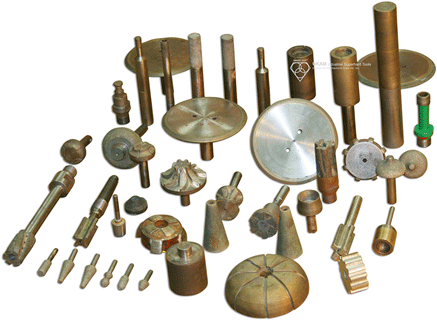
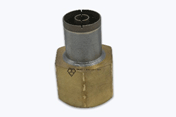
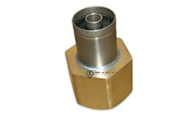
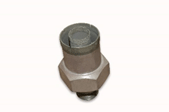
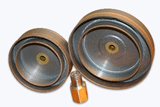
dual core drills are used to produce one single part/ring these will drill out the core and drill hole in material at same time hence increasing productivity and dimensional accuracy of different parts we can grind the outside and inside diameter of these tools to very high precision tolerances grind slots to improve cutting speed, and grind various radiuses
Non core formation Drills / Bottoming Drills

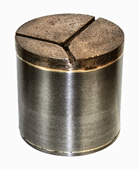
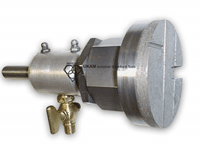
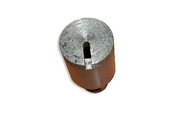
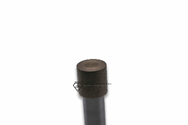
Diamond Bottoming Drills/Tools, sintered (metal bond) are used for making Blind Holes in all types of material ranging in hardness from sapphire, to quartz and slate. A bottoming tool does not have a core, and essentially works as both a diamond drill and grinding disc. The bottoming tools works by grinding the bottom and inside of the hole to a flat surface.
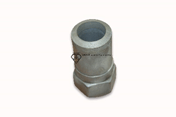
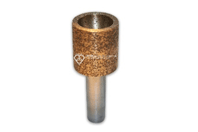
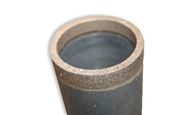
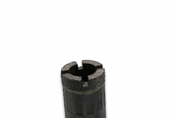
Off centric Diamond Drill
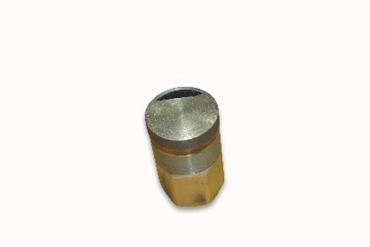
Designed with what is commonly called Half Moon shaped ID, allowing the core drill to move material and coolant at the same time as it drills the hole. ID (Inside Diameter) of the Diamond Drills/Bit is made larger (off center). OD (outside diameter) is made smaller to accomplish this purpose.
Non Coring / DISINTEGRATING ID Diamond Drill
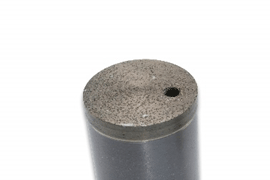
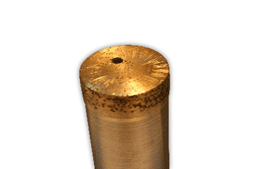


Inside diameter of this diamond drill is offset. It is still considered a diamond core drill because it has a slot on side for coolant to pass through center of the diamond drill. This type of diamond drill leaves no core behind (destroys core when drilling), because its ID (inside diameter) is Offset.
Diamond Countersinks, Diamond Counterbores, & Diamond Chamfer Tools

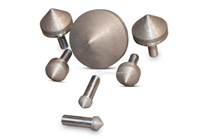



diamond & cbn countersinks are used to create conical holes, expanding existing holes, breaking corners and chamfering holes and polishing existing holes in large variety of materials. Available from stock in many specifications and we can also custom manufacture to fit almost any application/requirement.
diameters: .003” (75 microns) to 8” (200mm)
Angle/Radius: almost any
diamond bond types: Sintered (metal bond), Nickel Bond, Brazed Bond, PCD (polycrystalline diamond) , CVD (chemical vapor deposition) diamond
Diamond Drills & Tools for ultrasonic technology
Our ultrasonic tools for ultrasonic drilling, ultrasonic grinding and ultrasonic milling are, due to their technical properties, the solution for the ultrasonic processing of brittle hard materials. The bond hardness, the material of the bond matrix, the grain quality and the diamond concentration are designed so that they can withstand the additionally generated oscillating movement kinematics when using ultrasound.
Slotted Diamond Drill Design
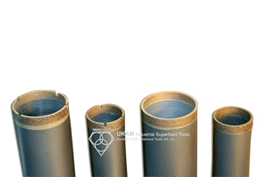
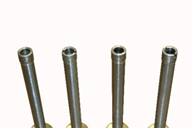


Making slots in diamond drill tip will usually make them drill faster and freer in hard materials. Slots help reduce diamond drill heat generation, and better propel coolant through the drilling zone. The width of slot depends on hardness of material. Diamond Drills manufactured for drilling harder materials require more slots than diamond drills made for softer materials. Slots are recommended for thick wall diamond drills, helping increase drilling speed and efficiency.
Find out more... What you should know before you buy your next diamond drill
For more & help on selecting the right diamond drill for your application. Contact UKAM Industrial Superhard Tools Engineering Department at Phone: (661) 257-2288.
Understanding Material Hardness & its Affect on Diamond Drill/Bit Performance

Material Hardness has several meanings. Most common definition for material hardness refers to its ability to resist deformation. Scientifically hardness is defined by energy density (energy per unit volume) required to create strain in material. While there are many ways, scales, and classification schemes to measure material hardness. In this article we will address the most simple explanation.
Mohs scale of Abrasion Hardness is the most simple and well known material hardness measurement and classification methods. In this scale material hardness is measured by scratch test of rubbing each material against another. All material harnesses are arranged in 10 ranks. Each rank is calibrated by a standard mineral. Below find these minerals in their rank of hardness from softest to hardest.
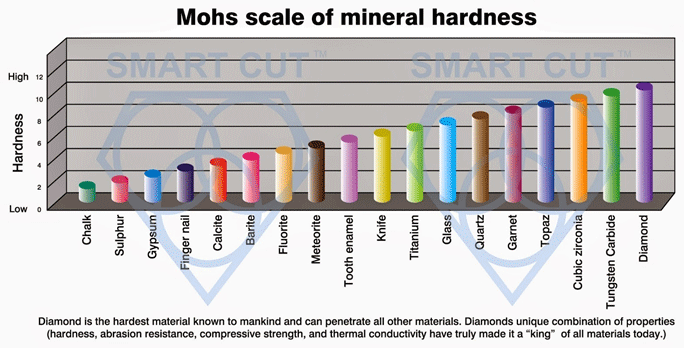
Mohs Scale of Hardness
Hierarchy of Material Hardness
Hierarchy
Rank
Examples of Minerals / Materials
Ultrasoft
< 5
graphite, salt, talc, lead, teflon
Soft
5-8
silver, copper, calcite, fluorite
Normal
8-10
magnesia, glass, steel, quartz
Hard
10-12
WC, SiC, Al203, Si3N4, B4C
Superhard
> 12
cubic boron nitride, Diamond
Proposed Scale of Hardness for Industrial Materials
Material
Formula
Mohs Hardness
Knoop Hardness
Rank
Industrial Hardness
Graphite
C
1 -
12
3.6
3
Molybdenite
MoS2
1 -
17
4.1
4
Aluminum, annealed
Al
2 -
25
4.6
Table Salt
NaCl
2
30
4.9
Gypsum
CaSo4
2
32
5.0
Silver
Ag
2+
60
5.9
6
Mild Steel, annealed
Fe
2+
123
6.9
Calcite
CaCO3
3
135
7.1
7
Copper
CaCO3
3
135
7.1
7
Indium Antimonide
InSB
4+
220
7.8
8
Magnesia
MgO
5-
370
8.5
Glass
Soda lime
6-
530
9.0
9
Tool Steel
Fe
6+
700
9.5
9
Quartz
SiO2
7
820
9.7
Chromium
Cr
7
935
9.9
Zirconia
ZrO2
8-
1160
10.2
10
Cemented WC
WC-Co(8%)
8-
1200
10.2
Beryllia
BeO
8-
1250
10.3
Silicon
Se
8
1400
10.5
Titanium nitride
TiN
9-
1800
10.8
Corundum
Al203
9
2100
11
11
Silicon Nitride
Si3N4
9
2100
11
Tungsten Carbide
WC
9+
2400
11.2
Titanium Carbide
TiC
9+
2470
11.3
Silicon Carbide
SiC
9+
2880
11.5
Boron Carbide
B4C
9+
3000
11.6
Sintered cBN
BN
10-
3200
11.6
Cubic boron nitride
BN
10-
4800
11.6
12
Sintered diamond
c
10-
5000
12.3
Diamond (Type IIa)
c
10
9000
13.1
13
Understanding Diamond Drill/Bit Bond Types & their Application
Sintered (Metal Bond) Diamond Drills


Metal bonded diamond core drills have diamonds sintered and multiple layers of diamonds impregnated inside the metal matrix. Diamonds are furnaces sintered in a matrix made of iron, cobalt, nickel, bronze, copper, tungsten, alloys of these powders or other metals in various combinations. Metal Bonded Diamond Tools are “impregnated” with diamonds. The compacted materials are then hot pressed or sintered to full density. Heating rate, applied pressure, sintering temperature and holding time, are all controlled according to the matrix composition.
This means that selected diamonds are mixed and sintered with specific metal alloys to achieve the best cutting performance possible on any materials such as sapphire, advanced ceramics, optics, glass, granite, tile and etc. The metal bond surrounding the diamonds must wear away to continuously keep re-exposing the diamonds for the diamond tool to continue cutting. Sintered (metal bonded) diamond tools are recommended for machining hard materials from 45 to 75 on Rockwell Scale (5 to 9.5 on mohs scale of hardness). As a general rule of thumb, Metal Bond (sintered) diamond drills last longer than other diamond drills available.
They can be used in almost all diamond drilling application ranging from very soft & abrasive materials to ultra hard materials. Typical applications include in order from hardness: Composites, Glass, Concrete, Sandstone/flagstone, Natural Stone, Optical Materials, Precious & Semiprecious stone, Advanced/Technical Ceramics, Advanced Materials, & Many Others. Sintered (metal bonded) diamond drills/bits are used & preferred in most Industrial/Manufacturing, R & D, Professional Contractor, & Serious Hobby Enthusiast / Craftsmen users. Sintered (metal bond) diamond core drills/bits are most widely used diamond drills across almost all industries & applications. They wear evenly, and are known for their long life & consistency. Precision & Accurate tolerances either on OD, ID, Run Out & Concentricity can only be obtained with sintered (metal bond) diamond drills.
Sintered (metal bond) diamond core drills/bits Require PROPER USE & SOLID UNDERSTANDING of Proper Diamond Drill/Diamond Tool Principals. Experience well help as well. Careless handling or use in imprecise machinery will result in diamond drill wrecking/breaking, bending or cracking the bond and will prevent future use.
Drilling life will vary with manufacturer & application/material factors described in this guide below. While there is no way to accurately predicting diamond drill life, with most conventional sintered (metal bonded) diamond drills, you can expect 350 to 1200 holes, parts machined, or cores. In laboratory tests, Diamond Drills with SMART CUT™ technology have shown to last 2,000+ holes on many applications/materials. Sintered (metal bonded) diamond core drills/bits with SMART CUT™ technology are the latest technology available in diamond drills. And represent the best value and performance per hole or part.
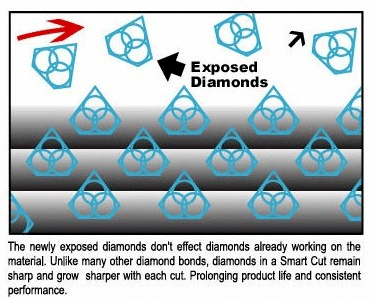

Electroplated (Nickel Bond) Diamond Drills
Electroplated Diamond Core Drills & Electroplated Thin Wall Diamond Core Drills have a high diamond concentration and maximum diamond particle (grit) exposure/protrusion ratio. This provides freer, faster drilling action with minimum heat generation. Electroplated Diamond Drills provide excellent performance on softer materials ranging from 6 to 1 on mohs scale of hardness. While electroplated diamond drills, specifically manufactured by UKAM Industrial, will still work on harder materials (up to 9 on mohs scale). Diamond drill life will be (very short) significantly reduced. Diamonds stay on the surface of the drill allowing for fast material removal. Perfect for softer, more ductile, and gummable materials.

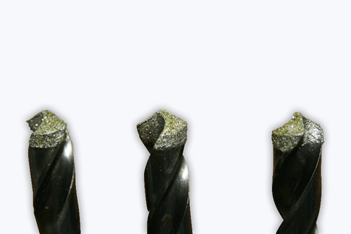


Not recommended for drilling very abrasive materials such as sandstone and concrete (they will wear out on these materials almost immediately). Electroplated Diamond Drills last less than metal bond, hybrid bond drills and are the least expensive diamond drills available. They provide very smooth surface finish quality & less thermal damage to the part being drilled.

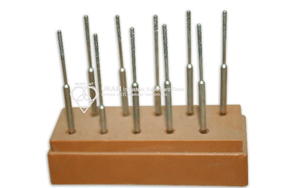
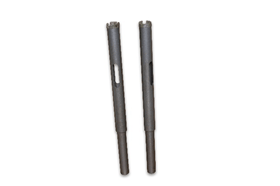
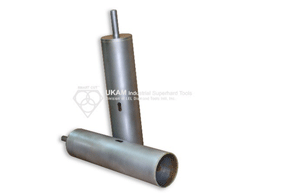
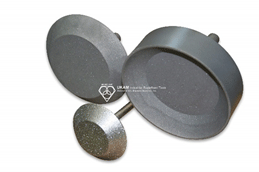

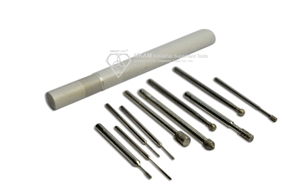
Electroplated diamond drills are frequently used in glass and composite industries (as well as some photonics / optics) applications. Electroplated Diamond Drills are designed for small & occasional use. They are widely used by beginning diamond drill users (novices) in numerous hobby/craft applications. As well as home owners and contractors requiring to drill a few holes when installing tile, marble, shower doors, glass mirrors, and etc. (not recommended for professional or serious industrial use). They are also usually more forgiving to operator/user drilling mistakes than most other types of diamond drills/bits. Electroplated core drills are just about the only type of diamond drill that may be used dry (without coolant) in a few applications if needed. Best performance and results will be achieved when drilling less than 1/4" (6.35") into material. Performance in many applications will decline when drilling thicker materials.
Brazed Bond Diamond Drills
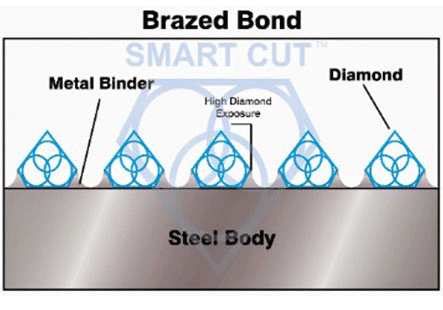
Brazed Diamond Diamond Drills are produced using and process that creates a fusion between the diamonds and the metal bond. While they may appear similar to electroplated (nickel bond) diamond drills. They are produced utilizing completely different process. Brazed Bond Diamond Drills are produced inside vacuum oven at a high temperature, single layer of diamond crystal bonded to steel body with very high diamond exposure.
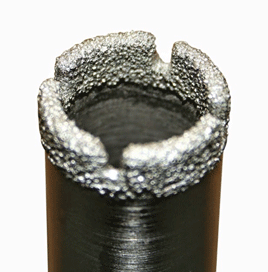

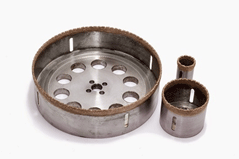
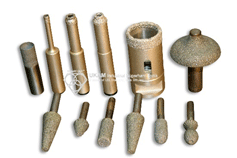
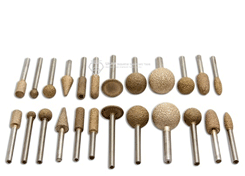
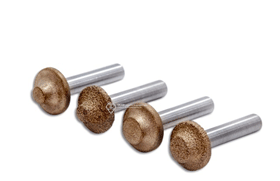
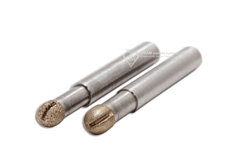

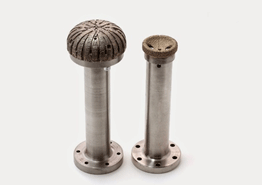

Brazed Bond Diamond Drills are perfect for drilling and machining tough-to-cut materials where fast stock removal and deep cuts are required. Including applications such as: non-metallic materials such as graphite epoxy, FRP, graphite, fiberglass, friction material, honeycomb and other composites.
PCD (Polycrystalline Diamond) is composed of diamond particles that are sintered with a metallic binder at extreme temperatures and pressures, creating the hardest and one of the most abrasion resistant materials used in cutting tools. These inserts are braised on to cutting tools and are used in machining applications in many applications where you find carbide tooling that includes sawing, routing, drilling and profiling to maximize tool life and reduce production cost
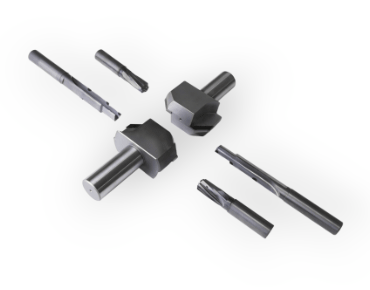

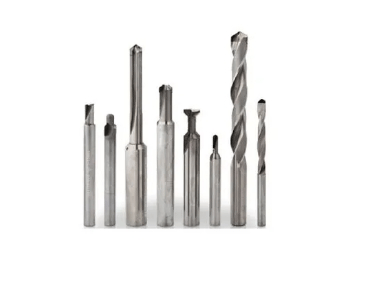
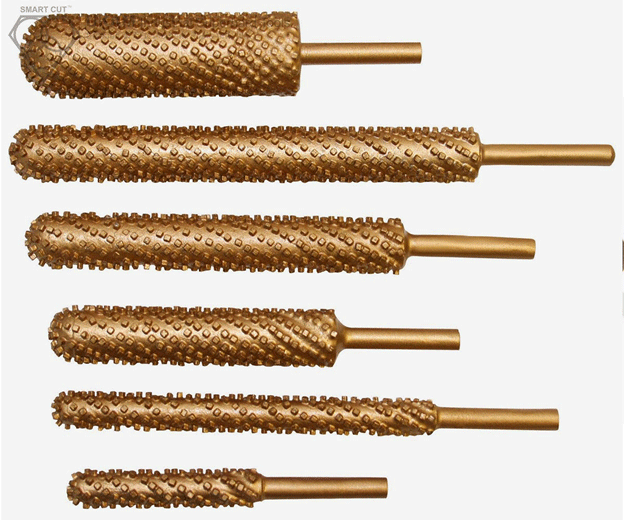
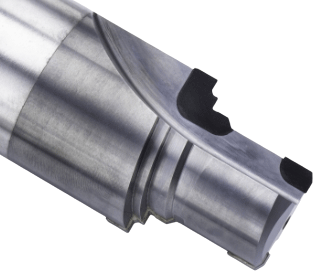
Application of PCD & Tools
PCD tools are used for processing aluminum and aluminum, aluminum alloys, copper, copper alloy, babbitt metal, wood, wood based fiber materials, aluminum oxide, reinforced floor boards, wear resistant plastic, Bakelite, graphite, stone materials, tungsten carbide, hard cartons. Epoxy resins, Fiberglass composites, Carbon-phenolic, Hard rubber, Plastics, Ceramics (unfired), Graphite
PCBN cutting tools are used for hardened steel, tool steel, mold steel, bearing steel, chilled cast iron, high chromium cast iron, nickel based high temperature alloy, gray cast iron, zinc alloys, sintered tungsten carbide & many other nonferrous materials that are difficult to machine.
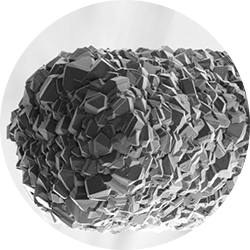

CVD (Chemical Vapor Deposition) Diamond Tools
CVD diamond coating takes place in a vacuum chamber using a hot-filament, chemical vapor deposition (CVD) process. Carbon gases are introduced into the vacuum chamber where high temperatures cause carbon atoms to re-bond into a 100% pure crystalline diamond structure. The crystalline diamond slowly grows on the surface of cutting tools (usually made from carbide) forming a continuous coating of up to 20 microns in thickness. Standard carbide tooling with this type of coating depending on application will last 10 to 50 times longer.
Application of CVD Tools
Used on softer and gummy materials where usually tungsten carbide tooling is used by wears out or has to be reshaped quickly. Applications such as machining graphite, hard carbon, green ceramic, carbon fiber, reinforced polymers, fiberglass, plastics, wood laminates, non ferrous metals
Evaluating Diamond Drill/Bit Performance
The performance of a diamond drill/bit for just about any application / material can be evaluated under various criteria. The importance of any criteria depends on your requirements.
Diamond Drill Life - The life of a diamond drill/bit is determined by the number of holes or it can drill (parts machined). It is fairly difficult to estimate the life of diamond drill. Diamond drill life is affected by various factors such as the application, bond type, drill manufacturer, and experience of user in properly using the drill. Diamond drill life will be discussed in further detail in this guide below. The following considerations play a major role in diamond drill life:
-
 hardness and abrasiveness of the material being drilled
hardness and abrasiveness of the material being drilled
-
 speed and power of drill
speed and power of drill
-
 amount of pressure used (feed rate)
amount of pressure used (feed rate)
-
 proper use of coolant (type of coolant, coolant force, & direction)
proper use of coolant (type of coolant, coolant force, & direction)
-
 Drilling Depth
Drilling Depth
-
 Material Holding Method
Material Holding Method
-
 operator experience (Understanding Proper Diamond Drill Usage Principals and Adjusting them as need to better fit their particular application & objectives)
operator experience (Understanding Proper Diamond Drill Usage Principals and Adjusting them as need to better fit their particular application & objectives)
-
 overall age and condition of drilling equipment (precision, accuracy, & repeatability of drilling equipment used)
overall age and condition of drilling equipment (precision, accuracy, & repeatability of drilling equipment used)
-
 quality, hardness, sharpness, and mesh size of the diamonds
quality, hardness, sharpness, and mesh size of the diamonds
-
 hardness of the bond compared to the material being drilled
hardness of the bond compared to the material being drilled
-
 experience and technology of manufacturer in keeping diamonds in the bond
experience and technology of manufacturer in keeping diamonds in the bond
Surface Finish Quality - The quality of the surface finish is evaluated by the amount of chips generated on the face of the material. Surface finish consists of three basic components: form, waviness and roughness. Although there are more then 100 ways to measure a surface and analyze results. A visual check is the most simple & easiest way of measuring (checking) surface finish quality. The most common scientific way of measuring surface finish quality is using Ra, or Arithmetic Average Roughness. It basically reflects the average height of roughness component irregularities from a mean line. Ra provides a simple value for accept/reject decisions.
Break in time - A diamond drill requires time to break in, to produce relatively chip free performance. The period of time under which this occurs, separates one diamond drill/bit from another.
Frequency of Dressing - The less you have to dress your diamond drill, the better off you will be.
UNDERSTANDING DIAMOND DRILL LIFE & PERFORMANCE
How many holes will this diamond drill last?
Why did my diamond drill wear out after only ....
the list of questions goes on. These are just some of the typical questions that our engineering staff answers every day. To help you better understand the factors & variables that play a major role in life/performance of your diamond drill/bit we have written an explanation below. We hope you will find this guide helpful.
Material Hardness + Density + Drilling Depth + Material Shape/Geometry + RPM's + Feed Rate + Coolant Used + Drilling Equipment Type/Condition + Material Holding Method + Operator Experience
DIAMOND DRILL LIFE & OVERALL PERFORMANCE
Diamond Drill Life & Overall Performance will vary with material hardness, density, Drilling Depth. Few other factors that play a role in diamond drill life include: RPM's (drilling speed), Feed Rate, Geometry (shape) of Material, Coolant being Used, Coolant feed rate and Direction. Drilling Equipment, Material Clamping Method & experience of operator. While there is now way of accurately predicting Life of your diamond drill. It can be optimized by following Principals of Proper Diamond Drill / Tool Usage. There may also be some experimenting, as well as trial & error involved in the part of the end user. Highly experienced diamond drill users may find some variations in diamond drill life or performance even when working on same material & application for several years. While this phenomena is not too common, it does occur. The machining environment around us is constantly changing. A slight change or variation in any variable can have significant impact on your diamond drilling results. Material being drilled can vary in composition or density even when coming from same manufacturer or source.
Slight change in coolant feed rate, coolant direction, RPM's, even the way the material is held in place can make the difference. Frequently the cause of the problem may not be obvious and may take as much as several failed attempts to surface. Fore more information on optimizing your Diamond Drilling Operation to ultimate level of performance >>>
When encountering problems or variation in diamond drill performance. Few stop to think about or carefully examine their drilling process. Many users immediately suspect quality of the diamond drill and are quick in labeling the drill "Defective" or "Poor Quality". This is very rarely the case. Usually in over 90% of these cases the diamond drill itself was not at fault. Most Respectable & Experienced Diamond Drill Manufactures have rigid quality control and inspection processes set in place. Controlling everything from raw material input, output, to final inspection. What a number of diamond drill users don't realize the technical aspects & delicate nature of diamond drilling/machining process. Unlike carbide, high speed steel, & other types of drills. Diamond drill works by grinds away material on micro (nano) level. Carbide and other types drills on the other hand cut material with a sharp cutting edge. A simple example of the minute details and understanding that play a major role in your diamond drilling process. What is important to understand is that almost all diamond drill/bit users, regardless of experience or technical background will make some type of an unintended operator error while using their diamond drills/bits. With this in mind, UKAM Industrial Superhard Tools has assembled a list of most common diamond drill operator errors made by users in all industries & applications. Looking through this guide will help you RESOLVE MOST COMMON DIFFICULTIES you may have in using your diamond drills/bits, as well as AVOID MOST COMMON PROBLEMS in the first place. DIAMOND DRILL / BIT TROUBLESHOOTING GUIDE >>>
Selecting the Right Drilling Equipment
for your Diamond Drill/Bit & Application
Diamond Core Drills can be used on a wide variety of equipment, such as: Drill Press, Hand Held Drill, Angle Grinder, CNC & Milling Machines. For most applications we recommend a you use diamond drills on a drill press. The drill press provides uniform drilling consistency, tighter tolerances, and better overall performance. Although a drill press may cost you more than an angle grinder, hand held grinder, or hand held drill. It will pay of in the long run.
Although there are hundreds of different types of drill presses on the market. For the most part, drill presses can be classified as two different types:
Bench Drill Press - Used for smaller jobs. Usually bolted or clamped to table or bench top or stand. This is the smallest and least expensive type of drill press. Perfect for the hobbyist and beginner.
Floor Drill Press - Larger drill press. Usually has a base that stands directly on the floor of your shop. This drill press can be extended and adjusted for optimum use and movement. An operator may use this drill press in either sitting or standing position. This type of drill press can be found used in most machine shops and professional hobbyist.
Industrial / Production Drill Press - Heavy Duty type of drill press, similar to a milling machine. Usually come with adjusted RPM (variable speed), larger drilling table (area) for holding larger parts (material), more powerful motor, capability to use chuck or collet, move drilling head up and down, move table horizontally and vertically.
Specialty / Custom Drill Press - Manufactured for specific material / application. For example, when machining very abrasive materials the drill press will be made from special type of metal to minimize dust and corrosion. Come with ultra precise chucks, collets, water pumps and devices. With these types of drill press you are usually able to regulate drilling depth either electronically or by computer, maintain consistent speed and feed rate. More advanced drill presses today may have feed back mechanism that provides information on all of these variables.
Before Buying a Diamond Drill or Drill Press
When buying a Diamond Drill to fit your current Drill Press or buying a Drill Press to fit a Diamond Drill, we recommend you carefully examine both drill and drilling equipment specifications to make sure they are compatible. Some variables you should consider:
Motor - Drill presses run on electric motors rated in horsepower. Make sure the motor for the drill press you choose is powerful enough for the material you are planning to drill and the diamond drill you are planning to use. Most Bench Drill Presses have motors rated between .3 hp and .5 hp. Floor Drill Presses on the other hand have motors that run between .75 hp and 1.5 hp. We recommend you choose the highest power motor you can afford. Doing so will place less strain on your job and will allow you to be more flexible, if you decide to use another drill or drill a different type of material in the future.
Speed Control - You will need to adjust the speed (RPM) at which you diamond drills run, depending on the material you are planning to drill. A drill press will usually allow you to run your diamond drills between 500 RPM (Revoltutions Per Minute) to 3,500 RPM. Some Drill Presses only provide specific speed settings, such as 500, 1,000, 1,500, 2,00, 2,500, and 3,000 RPM. This may be acceptable to you, again depending on the diameter of the diamond drill and material you are planning to use it on. Before buying a drill press, make sure it will run at the Recommended RPM set for your diamond drills.
Throat Depth - Drill Press design usually limits the distance between the center of the spindle (where the diamond drill is placed) and front edge of the vertical post that is used to support the drill head. This is called the throat depth. When drilling a hole in the center of a round work piece such as a tabletop, the radius of your work piece will need to be less than the throat depth itself.
Spindle Travel - The spindle of a drill press moves up and down only a certain distance. The distance the spindle can move is called spindle travel. This determines the maximum depth of the holes you will be able to drill. The drilling depth of your diamond drill will need to reflect and consider the spindle travel of your drill press.
Table Adjustments - Most Drill Presses have a tilting worktable. Some have the capability to tilt 45 degrees left and 45 degrees right. Others can tilt a full 90 degrees in each direction. Before buying a drill press, make sure the model you are considering, can work with the angles you need to make for your application. It is also recommended that the table swing in the horizontal pane as well. An excellent type of drill press is the on that can spin completely around the post.
Head Adjustments - A number of Drill Presses supplement a tilting table with a tilting drill head. Tilting heads typically move 45 degrees left and right, and ease the mind-bending work of compound angles. We recommend you are comfortable with both the adjustment mechanism and the angle gauge before using or buying this type of drill press.
Drill Press Accessories - There are a number of accessories on the market that will make your drilling experience faster, easier, and provide better performance as well as lower cost per hole. A few important ones include:
-
 Water Swivel Adapters - used to supply water through the center of your drills. Increase drill life 40% to 75%, improve quality of hole, and surface finish.
Water Swivel Adapters - used to supply water through the center of your drills. Increase drill life 40% to 75%, improve quality of hole, and surface finish.
-
 Shank Adapters- thread into your diamond drill collet, and allow the diamond drill to be placed in the drill press chuck.
Shank Adapters- thread into your diamond drill collet, and allow the diamond drill to be placed in the drill press chuck.
-
 Vises and Clamps - Designed for your drill press worktable. Hold you material firmly in place while drilling.
Vises and Clamps - Designed for your drill press worktable. Hold you material firmly in place while drilling.
Hand Held Drills
Nothing beats the versatility and ease of use of a Hand Held Drill. Lightweight and portable, the hand held drill can be taken with you anywhere you go. Perfect for use on horizontal surfaces, and outside jobs. An excellent tool for beginning hobbyist, homeowner and construction contractor. Use a hand held drill where a drill press is not feasible.
Hand Held Drills are available in a wide selection of both corded electric and battery-powered cordless models. The drill type you choose will effect your drilling capability in terms of material and diameter of the hole. The first step in selecting the right hand held drill for your application is determining the size of holes you need to drill and in what materials will you are planning to drill.
Make sure you select the hand held drill that actually has the capacity to do the work you need. Doing so will make your jobs faster and easier. As well as avoid problems such as ruining the diamond drill or material, caused by drilling with the wrong hand held drill or hand held rill without enough capacity.
The following are some of the features you should consider when choosing the right hand held drill for your application:
Capacity
A hand held drill's capacity indicates the largest hole size you can drill. Most hand held drills are ranked according to the maximum diamond drill shank the chuck can hold. Most popular drill shank sizes are 3/8" and 1/2".
Power
Make sure your hand held drill has enough power to use the diamond drill at the recommend RPM. Hand held drills are ranked according to maximum horsepower the motor can give. If your hand held drill does not have enough power, your chuck capacity will be irrelevant. And you will not be able to drill the size of hole and material you need. Before buying a hand held drill, we recommend you compare the horsepower of the drill. By the same token, if you will be working only with small, or soft material, and need to drill only a few holes an inexpensive drill will probably be sufficient for your application. However, if you are planning to drill a large amount of holes, drill hard materials, or make deep holes and need to use your drill often, a more heavy duty and higher powered drill will be required.
When drilling, never force your hand held drills, doing causes a more wear and tear on your drill, than associated with normal usage. Hence, decreasing your machines life and deteriorating future performance.
Angle / Hand Held Grinders
Angle / Hand Held Grinder offers the advantage of low cost, and increasing versatility. With this one piece equipment you can drill, cut, grind, and polish. An angle grinder is excellent choice for small jobs, outside jobs, drilling hard to reach places, or when drilling a very large piece of material. Where using a conventional drill press is not feasible.
CNC / Milling Machine
The best drilling results, precision tolerances, surface finish, and consistency will be obtained on a CNC / Milling Machine. An ideal choice for high production drilling operations. This equipment is fully automatic and controlled by a computer. And costs more than other types of drilling equipment.

